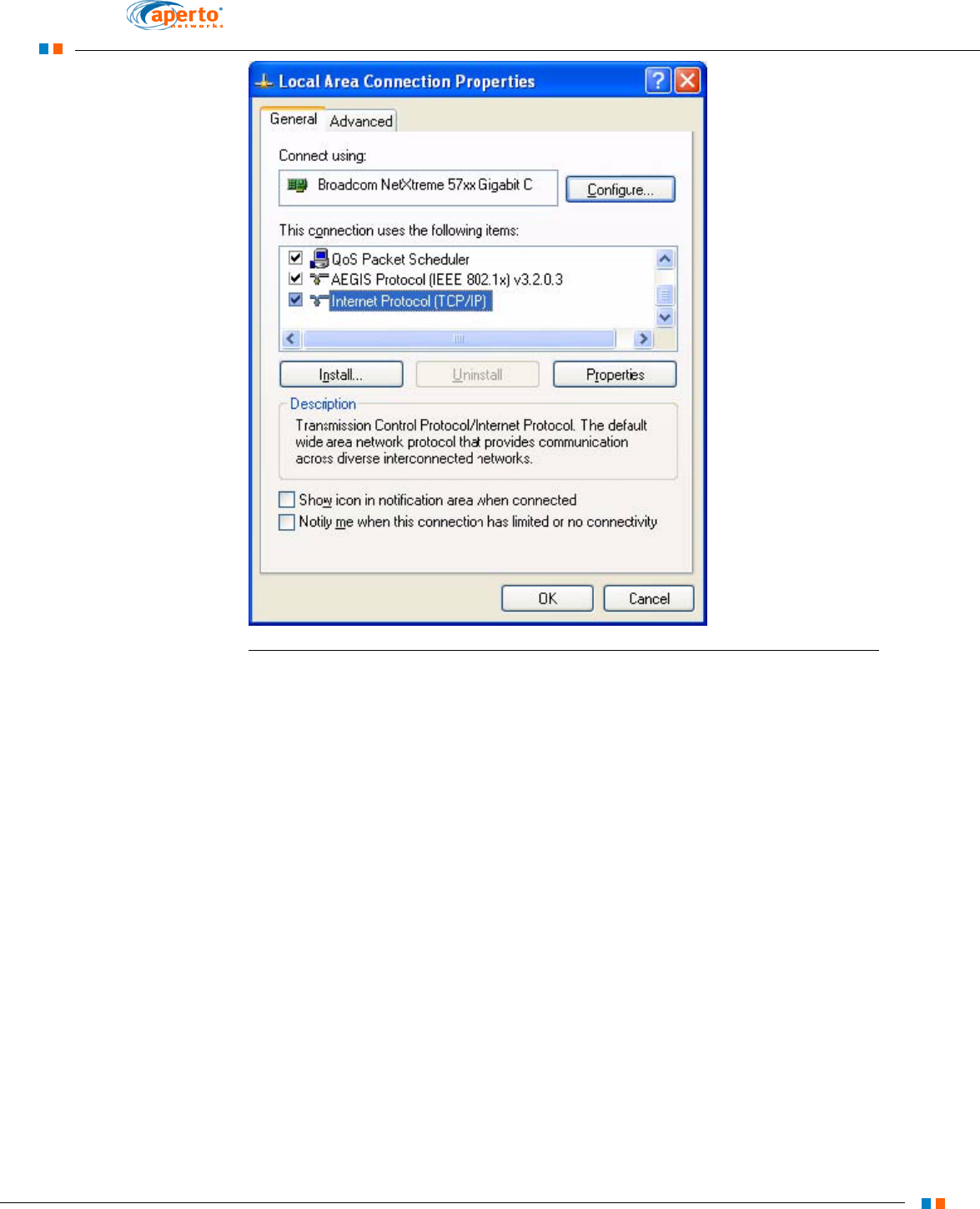Aperto Networks PM58-BS 5.8 GHZ WLAN Base Station User Manual PM 100 Manual Rev A
Aperto Networks 5.8 GHZ WLAN Base Station PM 100 Manual Rev A
Users Manual
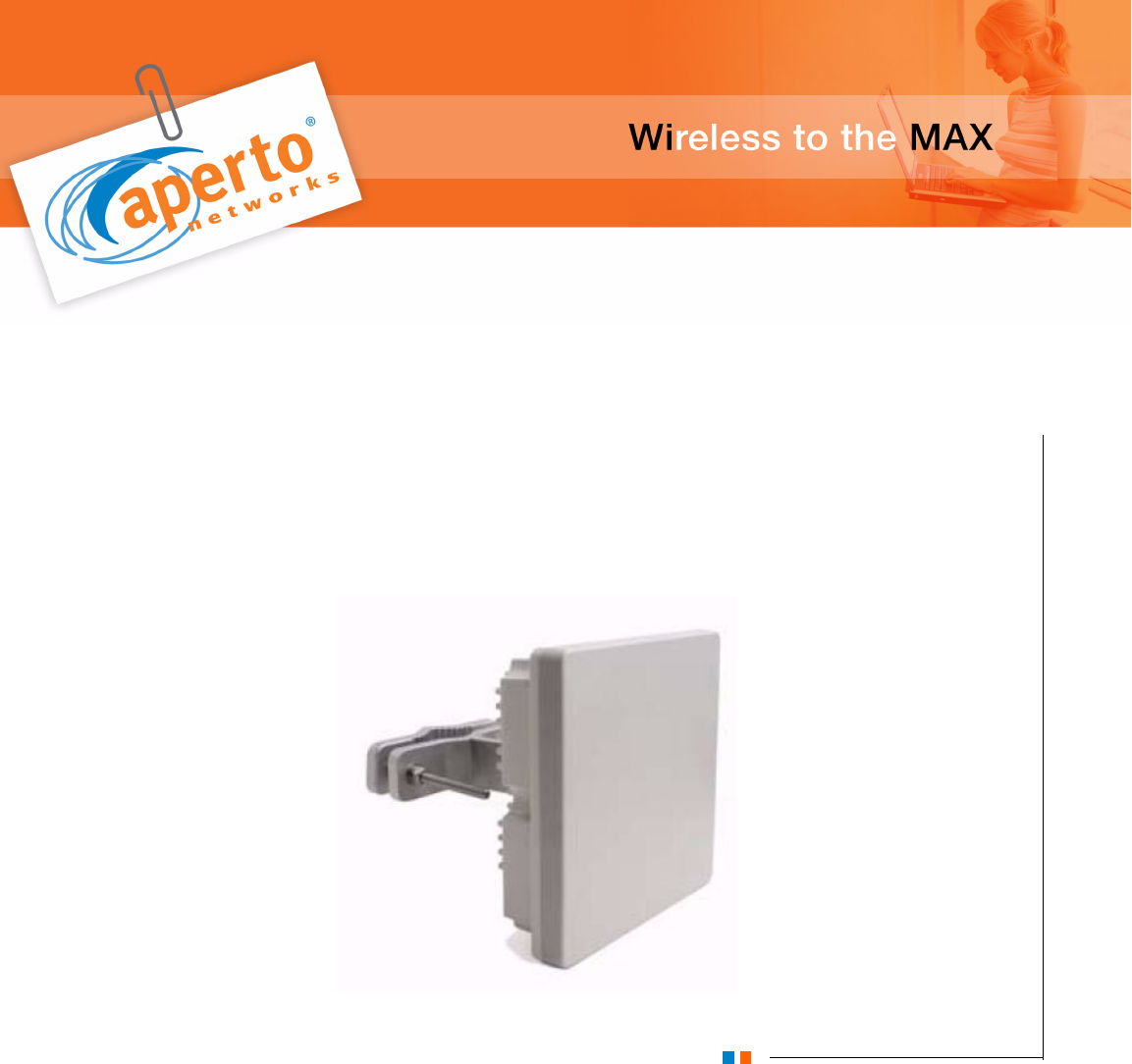
10007306 Rev J
Aperto PacketMax
PacketMax 100/300
(Feb 2008)
Installation and Operation User Manual
©Copyright 2007-08 by Aperto Networks
All rights reserved.
Specifications subject to change.
Aperto, PacketMax, and WaveCenter are trademarks of Aperto Networks.
All other trademarks used herein are the property of their respective owners.
Aperto Networks
598 Gibraltar Drive
Milpitas, CA 95035 USA
Phone: 408.719.9977
Fax: 408.719.9970
www.apertonet.com

Aperto WaveCenter
Regulatory Information
CE Notice
Declaration of Conformity
Aperto Networks Inc. of 598 Gibraltar Drive, Milpitas CA 95037, USA, declare under our sole respon-
sibility that the product PacketMax 3.5 GHz system (3.4-3.7 GHz operation) to which this declaration
relates, is in conformity with the following standards and/or other normative documents.
• EN 301 753
• EN301 489-4
• EN60950
We hereby declare that all essential radio test suites have been carried out and that the above named
product is in conformity to all the essential requirements of Directive 1999/5/EC.
The conformity assessment procedure referred to in Article 10 and detailed in Annex [III] or [IV] of
Directive 1999/5/EC has been followed with the involvement of the following Notified Body: Compli-
ance Certification Services, 561F Monterey Road, Morgan Hill, CA 95037
0984
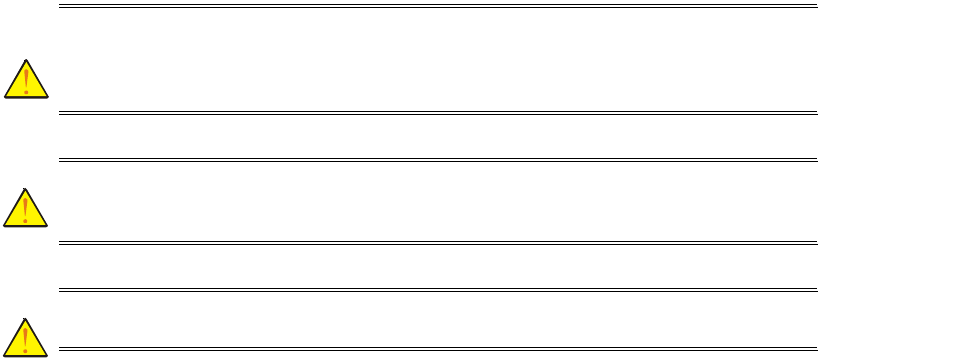
Aperto WaveCenter
UL Information
CAUTION: For the CATV system, the CATV installer should install in accordance with Article 820-
40 of the NEC which provides guidelines for proper grounding and, in particular, spec-
ifies that the cable ground shall be connected to the grounding system of the building,
as close as possible to the point of cable entry as practical.
CAUTION: The external exposed (outdoor) run of the cables, from the exit of the building to the
antenna/radio assembly, should be less than 140ft, while the total cable run is as
described in this manual.
CAUTION: For Model 100/300, the Power Over Ethernet box is intended to be installed indoor
only and the Radio/Antenna is intended to be installed outdoors.

Aperto WaveCenter
Waste Electrical and Electronic Equipment (WEEE) Directive Compliance
Aperto Network products sold within the European Union (EU) are subject to the requirements of
the Waste Electrical and Electronic Equipment (WEEE) Directive; as implemented by national
legislation in each EU country. The objective of the Directive is to reduce the environmental
impacts of WEEE by promoting re-use and recycling, as an alternative to disposal.
From 13 August 2005, product placed on the EU market is required to be marked with the symbol
shown below. This symbol indicates that end-of-life electronic equipment generated within the
EU should not be mixed with other types of waste or placed in the general waste stream; but
should be segregated for the purpose of re-use or recycling.
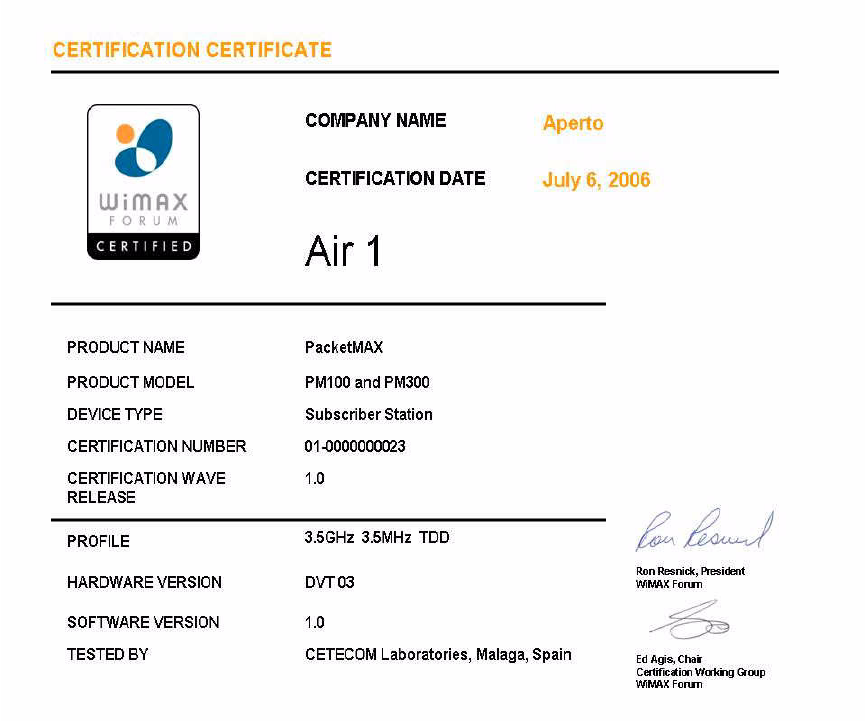
Aperto WaveCenter

–i
PacketMax 100/300 User Manual, 10007306, Rev J
Table Of Contents
Scope of This Manual . . . . . . . . . . . . . . . . . . . . . . . . . . . . . . . . . . . . . . -i
Conventions Used in This Manual . . . . . . . . . . . . . . . . . . . . . . . . . . . . -i
Intended Audience for this Manual . . . . . . . . . . . . . . . . . . . . . . . . . . . -ii
General Cautions and Warnings . . . . . . . . . . . . . . . . . . . . . . . . . . . . . . -ii
List of References . . . . . . . . . . . . . . . . . . . . . . . . . . . . . . . . . . . . . . . . . -iii
Chapter 1. Overview Of Subscriber Station
PM 100/300 Package Contents . . . . . . . . . . . . . . . . . . . . . . . . . . . . . . . 1-2
Subscriber Station . . . . . . . . . . . . . . . . . . . . . . . . . . . . . . . . . . . . . . . . . 1-2
PacketMax 100/300 Outdoor Unit (ODU) . . . . . . . . . . . . . . . 1-2
PacketMax Indoor Unit - PoE (IDU) . . . . . . . . . . . . . . . . . . . 1-3
VLAN Mode . . . . . . . . . . . . . . . . . . . . . . . . . . . . . . . . . . . . . . . . . . . . . 1-4
Management, Configuration and Diagnostic Functions . . . . . . . . . . . . 1-4
Upgrades . . . . . . . . . . . . . . . . . . . . . . . . . . . . . . . . . . . . . . . . . 1-4
SS Configuration . . . . . . . . . . . . . . . . . . . . . . . . . . . . . . . . . . 1-4
MIB . . . . . . . . . . . . . . . . . . . . . . . . . . . . . . . . . . . . . . . . . . . . 1-5
Event Reporting . . . . . . . . . . . . . . . . . . . . . . . . . . . . . . . . . . . 1-5
3 DES Encryption . . . . . . . . . . . . . . . . . . . . . . . . . . . . . . . . . . 1-5
Certificates and Management . . . . . . . . . . . . . . . . . . . . . . . . . 1-7
Chapter 2. Installation of Subscriber Station
Installation Requirements . . . . . . . . . . . . . . . . . . . . . . . . . . . . . . . . . . . 2-2
Hardware and Software Requirements . . . . . . . . . . . . . . . . . . 2-2
Cables and Connector Requirements . . . . . . . . . . . . . . . . . . . 2-2
Tools requirements . . . . . . . . . . . . . . . . . . . . . . . . . . . . . . . . . 2-3
Before Installation . . . . . . . . . . . . . . . . . . . . . . . . . . . . . . . . . 2-3
Installation Process . . . . . . . . . . . . . . . . . . . . . . . . . . . . . . . . . . . . . . . . 2-4
Chapter 3. Aperto Installation Manager
Aperto Installation Manager Requirements . . . . . . . . . . . . . . . . . . . . . 3-2
Installing the AIM Software on the PC . . . . . . . . . . . . . . . . . . . . . . . . 3-2
Connecting to the PacketMax 100 . . . . . . . . . . . . . . . . . . . . . . . . . . . . 3-2
Working with the Aperto Installation Manager . . . . . . . . . . . . . . . . . . 3-3
Logging into Aperto Installation Manager . . . . . . . . . . . . . . . 3-3
AIM Options . . . . . . . . . . . . . . . . . . . . . . . . . . . . . . . . . . . . . 3-4
Importing the BS XX.DAT File . . . . . . . . . . . . . . . . . . . . . . 3-5
Basic Configuration . . . . . . . . . . . . . . . . . . . . . . . . . . . . . . . . 3-5
Aligning the Antenna . . . . . . . . . . . . . . . . . . . . . . . . . . . . . . . 3-9
Re-aligning the Antenna (Continue with Setup Mode) . . . . . 3-10
Aperto Installation Manager Troubleshooting . . . . . . . . . . . . . . . . . . . 3-11
Table Of
Contents

Table Of Content
–ii
PacketMax 100/300 User Manual, 10007306, Rev J
Problems Connecting to the Subscriber Unit . . . . . . . . . . . . . 3-11
Problems Communicating with the Base Station Unit . . . . . . 3-11
Buzzer in AIM . . . . . . . . . . . . . . . . . . . . . . . . . . . . . . . . . . . . . . . . . . . 3-12
Appendix A. Specifications
General Specifications . . . . . . . . . . . . . . . . . . . . . . . . . . . . . . . . . . . . . A-1
Models . . . . . . . . . . . . . . . . . . . . . . . . . . . . . . . . . . . . . . . . . . A-1
Interfaces . . . . . . . . . . . . . . . . . . . . . . . . . . . . . . . . . . . . . . . . A-1
Power requirements . . . . . . . . . . . . . . . . . . . . . . . . . . . . . . . . A-1
RF and antenna specifications . . . . . . . . . . . . . . . . . . . . . . . . A-2
Performance and capacities . . . . . . . . . . . . . . . . . . . . . . . . . . A-2
Receive Threshold Specifications . . . . . . . . . . . . . . . . . . . . . A-3
Mechanical and environmental specifications . . . . . . . . . . . . A-4
Mounting and Brackets . . . . . . . . . . . . . . . . . . . . . . . . . . . . . A-4
Regulatory Standards . . . . . . . . . . . . . . . . . . . . . . . . . . . . . . . A-4
Appendix B. Event Reporting
ALarms and Events . . . . . . . . . . . . . . . . . . . . . . . . . . . . . . . . . . . . . . . B-2
PacketMax 100/300 and PacketMax 5000 Events . . . . . . . . . . . . . . . . B-2
Appendix C. Cables, Spares and Accessories
PacketMax 100/300 CPEs, Cables and Spares . . . . . . . . . . . . . . . . . . . C-1
PacketMax 100/300 CPEs . . . . . . . . . . . . . . . . . . . . . . . . . . . C-2
PacketMax 100 Cables . . . . . . . . . . . . . . . . . . . . . . . . . . . . . . C-2
PacketMAX Subscriber Station Spares and Surge Protector . C-3
Rubber Boot . . . . . . . . . . . . . . . . . . . . . . . . . . . . . . . . . . . . . . . . . . . . . C-3
Appendix D. Command Line Interface (CLI)
Accessing and Using the CLI . . . . . . . . . . . . . . . . . . . . . . . . . . . . . . . . D-1
Commands . . . . . . . . . . . . . . . . . . . . . . . . . . . . . . . . . . . . . . . D-2
Error Messages . . . . . . . . . . . . . . . . . . . . . . . . . . . . . . . . . . . . D-2
Appendix E. Virtual Local Area Network
Bridge and VLAN Mode . . . . . . . . . . . . . . . . . . . . . . . . . . . . . . . . . . . E-2
Out of band Management with Management VLAN . . . . . . . . . . . . . . E-2
Inband Management with Management VLAN . . . . . . . . . . . . . . . . . . E-3
VLAN Classifiers . . . . . . . . . . . . . . . . . . . . . . . . . . . . . . . . . . . . . . . . . E-4
VLAN Application Example . . . . . . . . . . . . . . . . . . . . . . . . . . . . . . . . E-5
Looping Prevention . . . . . . . . . . . . . . . . . . . . . . . . . . . . . . . . . . . . . . . E-6
Subscriber Station scenarios . . . . . . . . . . . . . . . . . . . . . . . . . . . . . . . . . E-6
Behavior of SS VLAN . . . . . . . . . . . . . . . . . . . . . . . . . . . . . E-8

–iii
PacketMax 100/300 User Manual, 10007306, Rev J
Table Of Contents
Appendix F. Troubleshooting
Troubleshooting Issues and Tips . . . . . . . . . . . . . . . . . . . . . . . . . . . . . F-1
Booting SS from network . . . . . . . . . . . . . . . . . . . . . . . . . . . . . . . . . . . F-2
Appendix G. LIMITED EQUIPMENT WARRANTY (“Agreement”)
WARRANTY COVERAGE . . . . . . . . . . . . . . . . . . . . . . . . . . . . . . . . G-1
REMEDIES . . . . . . . . . . . . . . . . . . . . . . . . . . . . . . . . . . . . . . G-2
LIMITED LIABILITY . . . . . . . . . . . . . . . . . . . . . . . . . . . . . . . . . . . . . G-3

Table Of Content
–iv
PacketMax 100/300 User Manual, 10007306, Rev J

Preface - i
PacketMax 100/300 User Manual, 10007306, Rev J
This manual is part of the documentation for the PacketMax broadband wireless sys-
tem for delivering high-speed subscriber services.
Scope of This Manual
This manual documents the installation and operation of the PacketMax 100/300
Series subscriber equipment with software version 2.3.
This manual provides the following information:
•Chapter 1 Overview of Subscriber Station: Provides an overview of the
Aperto Subscriber Station, its components, and functions.
•Chapter 2 Installation of Subscriber Station: Provides step-by-step proce-
dure for installing the Aperto Subscriber Station.
•Chapter 3 Aperto Installation Manager: Walks you through the steps of
installing and using Aperto Installation Manager (AIM) tool.
•Appendixes: Provide additional information on System Specifications, Events
and Alarms, Cables, Spares, and Accessories, Command Line Interface,
VLAN, and Troubleshooting tips.
Conventions Used in This Manual
PacketMax manuals represent special kinds of text as follows:
• Files names and URLs are represented in italics, with variables described
inside angle brackets. For example, if the URL http://<IP address>/BS.htm is ref-
erenced, you will replace the variable <IP address> with the appropriate real IP
address.
• Management interface text is represented in a bold font: for example, the
Generate Config File button.
Preface
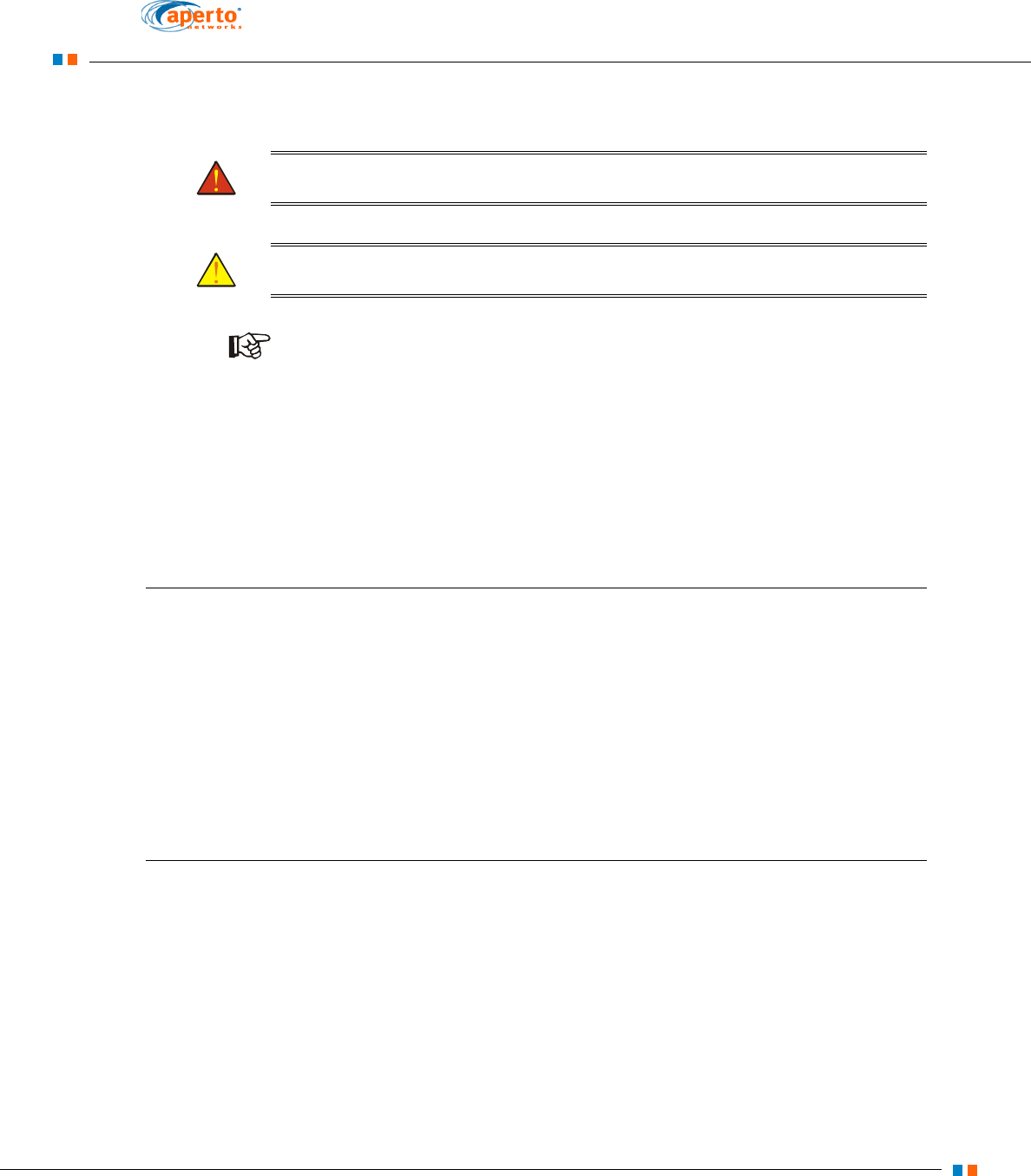
Preface
Preface - ii
PacketMax 100/300 User Manual, 10007306, Rev J
• Labels on equipment are represented in a bold font: for example, the Control
connector.
WARNING: This format is used to indicate the possibility of personal injury or
damage to equipment.
CAUTION: This format is used to indicate the possibility of system or equipment
operation problems.
NOTE: Items of special importance will be marked by a pointing-hand icon, as this
paragraph is.
For conceptual discussions, PacketMax 100/300 is used interchangebly with SS or
Subscriber Stations in many places of this user manual. Similarly, PacketMax 5000
and PM 3000 is used interchangebly with BS or Base Station in may places of this
user manual.
Further, Subscriber Station and Subscriber Equipment have been used interchange-
ably.
Intended Audience for this Manual
This manual is intended primarily for subscriber equipment installers. It also presents
information of use to subscribers, including a discussion of tools used for configura-
tion.
Installation of radio equipment involves numerous factors requiring considerable
expertise. It is assumed that equipment installers are professionals with a full under-
standing of the principles, standard practices and procedures of cell site installation,
with all relevant safety requirements, and with applicable local building codes.
General Cautions and Warnings
Observe the following when installing or operating any PacketMax System compo-
nents.
Carefully follow all local building and electrical codes, especially the latest revision
of the National Electrical Code (NEC) and standard safety procedures for install-
ing and working with this type of equipment. Improper procedures or installation
can result in damage to the equipment or the building, and injury or death. If you

Preface
Preface - iii
PacketMax 100/300 User Manual, 10007306, Rev J
are not sure about whether the installation follows these codes, contact a licensed
building inspector or electrician in the area for assistance.
Always use quality components—including cables, connectors, mounts, etc.—
specifically rated for your particular environmental conditions and system perfor-
mance requirements.
Always use appropriate tools, and follow the instructions of the tool
manufacturers.
All outdoor installation, including equipment mounting and cabling, should be per-
formed by trained microwave radio technicians familiar with usual and customary
practices and procedures.
Take extreme care to avoid contacting any overhead power lines, lights, and
power circuits while you are installing the Outdoor Unit. Contact with any of these
objects could cause injury or death. Do not install the Outdoor Unit near power
lines.
Make sure that the outdoor radio/antenna is grounded in accordance with local,
state, federal, and National Electrical Code (NEC) requirements. Pay special
attention to NEC sections 810 and 820. See the instructions in Chapter 4 of this
manual.
For the PacketMax 100 Series Indoor Unit, use an outlet that contains surge pro-
tection and ground fault protection, or use a surge protection device. This will
protect the Indoor Unit and equipment connected to it from damage resulting from
AC current surges, lightning, etc. For complete protection, all connections to the
Indoor Unit (i.e., from radio/antenna and PC/hub) should be connected to a surge
protection device. To ensure the best signal, use surge protectors designed for
the specific application.
RF Exposure Guidelines
In order to comply with FCC and Industry Canada requirements for maximum RF
exposure levels to persons, the antenna must be mounted in such a way that dur-
ing operation, a minimum separation distance of 21 cm is maintained between the
antenna and all persons.
Prohibition against Unauthorized Modifications
The user is cautioned that changes or modifications not expressly approved by
Aperto Networks could void the user’s authority to operate the equipment.
Units sold in the United States can only be used in the FCC specified band of
5.725 to 5.850 GHz.

Preface
Preface - iv
PacketMax 100/300 User Manual, 10007306, Rev J
Because Aperto Networks cannot be responsible for improper installation or use of its
equipment, failure to follow these and other published cautions and warnings may
void your equipment warranty.
List of References
WaveCenter EMS Pro User Manual
PacketMax 5000 Installation and Operation User Manual
PacketMax 3000 Installation and Operation User Manual

1–1
PacketMax 100/300 User Manual, 10007306, Rev J
Overview Of Subscriber Station
As part of Aperto Networks' PacketMax Broadband Multiservice Wireless Access Sys-
tem, the PacketMax 100/300 Series Subscriber Station delivers high-speed, always-
on Internet access to small and medium-sized businesses, small offices/home offices
(SOHO), and residences. The PacketMax System can be deployed in the standard
frequency bands, licensed or unlicensed, for wireless broadband networking. The
PacketMax products operate in 3.3/3.5/5.8 GHz Fixed Wireless Access (FWA) cur-
rently.
This Chapter covers the following topics:
PM 100/300 Package Contents
Subscriber Station
VLAN Mode
Management, Configuration and Diagnostic Functions
1
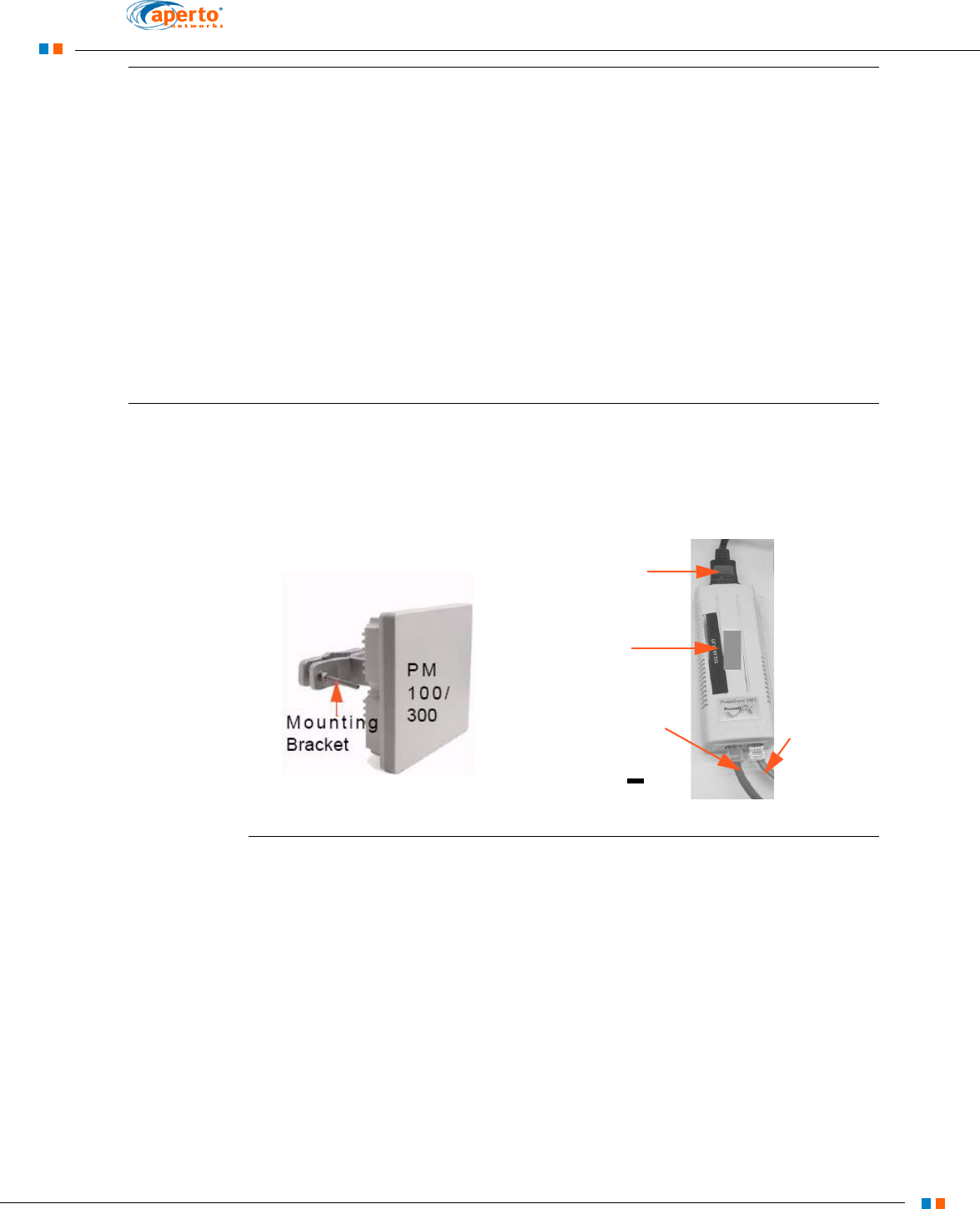
1–2
PacketMax 100/300 User Manual, 10007306, Rev J
Chapter 1. Overview Of Subscriber Station
1.1 PM 100/300 Package Contents
PM 100 or PM 300 Radio (ODU) with either an integrated antenna or Type-N
connector
Power-over-Ethernet Injector (IDU) and User Guide
Pole Mount Bracket Kit 1.0 to 3.0 inches (2.54 to 7.62 cm)
Weatherproof Connector
Cat5 indoor Ethernet Cable (5 ft/150 cm)
AC Power Cord
Quick Installation Guide and Warranty Card
1.2 Subscriber Station
PacketMax 100/300 Series subscriber stations consists of an Outdoor Unit (radio/
antenna), and a Power over Ethernet (PoE).
Figure 1-1 PacketMax Subscriber Equipment
1.2.1 PacketMax 100/300 Outdoor Unit (ODU)
The outdoor unit integrats all communication, networking, RF and antenna functions.
The ODU has a maximum average power output of 20 dBm at 64QAM modulation
and it supports variable channel widths 3.0, 3.5, 5.0, 5.5 and 7.0 MHz. The bandwidth
Management is handled by service flows such as CBR, CIR and BE.
The internal antenna has the following specifications:
15 dBi gain
Vertical Polarization
Data Out to
PM 100/300
ODU
Data In to
PC/hub
Power Over
Ethernet (PoE)
AC Supply

1–3
PacketMax 100/300 User Manual, 10007306, Rev J
Chapter 1. Overview Of Subscriber Station
PacketMax 100/300 ODU connects to the user’s Local Area Network and power
source (Power Over Ethernet block) through a single CAT 5e cable (RJ-45 connector).
This cable carries data as well as power to the ODU.
NOTE: You must use Aperto’s UV-protected CAT 5e cable with a rubber boot
to ensure compliance to the weather-proof IP-67 Standard.
1.2.2 PacketMax Indoor Unit - PoE (IDU)
The PacketMax 100/300 IDU is a PoE consisting of AC-DC convertor. Being a small,
free-standing unit, it can be placed anywhere within the subscriber’s premises. The
Indoor Unit has two interfaces, one connecting to the Outdoor Unit and the other con-
necting to subscriber’s LAN.
The IDU must meet the following basic requirements:
The unit must have access to AC power.
The cable connecting the IDU to the Outdoor Unit can be up to 100 m (330 ft).
The PoE must be upright, with adequate air flow around it.
The IDU (Power Over Ethernet) features consists the following:
Power cord that plugs into a standard AC wall plug (110-240 VAC).
10/100Base-T Ethernet port used to carry signal and power to ODU.
Auto-sensing 10/100 Base-T Ethernet port for customer network equipment.
The Indoor Unit is a bridge which, together with the Outdoor Unit, connects the sub-
scriber’s computer(s) to the wireless service.
NOTE: For management purposes, all Indoor Units—including those operat-
ing in bridge mode—require an IP address.
The IDU provides a visual indication of the power status, which will show:
Solid Green when the device is On.
Blinking Green overload or short circuit.
No display when the Power supply is off or there is no load present.
1.2.2.1 Automatic Frequency Selection
The PacketMax 100/300 Series supports Automatic Frequency Selection (AFS),
which helps to ensure optimal performance in less-than-optimal conditions. A total of
up to 20 frequencies within the unit’s frequency band can be selected. With AFS,
when interference degrades performance on the primary frequency, the BS will auto-
matically shift the link to a frequency providing satisfactory performance using QPSK.
The AFS parameters (candidate channels, reselection thresholds and time-outs) can
be configured from the WaveMax Element Management System (EMS). AFS is avail-
able for all frequency bands, licensed or unlicensed.

1–4
PacketMax 100/300 User Manual, 10007306, Rev J
Chapter 1. Overview Of Subscriber Station
1.3 VLAN Mode
The way SS operates in VLAN mode has been discussed in Virtual Local Area Net-
work. Please refer to Virtual Local Area Network, for information on SS in VLAN Mode
and different user scenario examples.
1.4 Management, Configuration and Diagnostic
Functions
The PacketMax 100/300 includes a number of features which provide management,
configuration, and diagnostic functions. They range from front-panel LEDs to an user
interface (through CLI), and include:
LEDs — LED indicators on the front of the Indoor Unit show status of the LAN
and wireless interfaces as well as power to the unit.
Aperto Installation Manager — This utility initializes newly-installed subscriber
equipment and allows antenna alignment for optimal wireless communication.
Use of the Aperto Installation Manager (AIM) is described in Chapter 5.
SNMP Agent — Each PacketMax 100/300 includes an SNMP agent which can
be accessed via a standard SNMP manager, either directly or through the Base
Station Unit’s proxy agent.
Command Line Interface — For basic diagnostics, a limited command line inter-
face (CLI) to the PacketMax 100/300 can be accessed via telnet.
1.4.1 Upgrades
There are two types of upgrades that can be done using the EMS, and they are:
Bulk Upgrade : The bulk upgrade feature of EMS allows the users to upgrade
the BS/SS efficiently.
LAN Upgrade: When there is network connectivity to the BS, users can
upgrade the SS using the LAN upgrade tool in EMS. This implies that LAN
Upgrade can be used typically in a laboratory environment.
1.4.2 SS Configuration
SS configuration can be done in server mode or in local mode:
In local mode, the SS’s configuration is performed using the Aperto Installation
Manager (AIM).
In server mode, subscriber equipment is provisioned using the WaveCenter
Configuration Manager, as described in the Element Management System
Installation, Configuration, and Operation manual. On boot-up, after getting
address and file information from its assigned DHCP server, the Packetmax
100/300 downloads its configuration file from the base station’s TFTP server.
Configuration of the Packetmax 100/300 can be performed via the EMS or CLIs.

1–5
PacketMax 100/300 User Manual, 10007306, Rev J
Chapter 1. Overview Of Subscriber Station
1.4.3 MIB
Each PacketMax 100/300 includes a SNMP agent supporting the following MIBs:
MIB II (RFC 1213)
Aperto private MIB
Wimax-IF-MIB (objects for 802.16 based SS and BS)
The complete MIBs are provided on the PacketMax CD-ROM.
SNMP can be used to read configuration, status, and performance data from Sub-
scriber Units. In addition, SNMP can be used to change some configuration parame-
ters (those which can be changed via the Configuration Manager in EMS), and to
upload the configuration changes to the TFTP server (if the TFTP server is configured
to accept uploads).
The SNMP agents support trap reporting. Trap-reporting parameters can be specified
via the Configuration Manager as well as via SNMP.
1.4.4 Event Reporting
PacketMax 100/300 Series Subscriber Units offer several means of reporting sub-
scriber equipment events:
E-mail messages — The Subscriber Unit can be configured (via the Element
Management System, or SNMP) to report events via e-mail to specified
addresses.
SNMP traps — The Indoor Unit’s SNMP agent supports trap reporting. Trap-
reporting parameters can be specified via the EMS ((WaveCenter Configuration
Manager), or SNMP.
Syslog — The Indoor Unit supports logging of event messages to a designated
server according to the Syslog protocol. If Syslog is employed, the Syslog
server must be identified in the Subscriber Unit configuration file created using
the WaveCenter Configuration Manager.
NOTE: Use of Syslog is strongly recommended as a means of providing a
record of system events for performance management and troubleshooting.
Event log — A historical event log can be displayed on request via the Faults
section in EMS.
1.4.5 3 DES Encryption
Security is a required feature in the current network, to ensure that the Base Station
and Subscriber Station communicate with each other. An encryption scheme is used
to secure the BS and SS communication channel by encrypting the data between the
two.
The Encryption procedure is as follows:
1. At first, the SS initiates the authorization process and sends message to the
BS indicating that it is capable of encryption.

1–6
PacketMax 100/300 User Manual, 10007306, Rev J
Chapter 1. Overview Of Subscriber Station
2. The BS authorizes the SS by verifying the device and Vendor Certificate of the
SS during the Privacy Key Management (PKM) Message Exchange.
3. An Authorization Key (AK) is used to decrypt the Traffic Encryption Keys
(TEKs) using PKM protocol. The AK is periodically refreshed and is encrypted
using 3DES.
4. In the BS, the TEKs are generated and send to SS using the 3DES encryption
format. The SS decrypts these TEKs using a Key Encryption Key (KEK) gen-
erated from the AK. If the BS encrypts the TEK using the RSA Public Key of
SS, then the SS decrypts it using its Private Key.
5. The TEKs are used for encrypting data on different Service Flows (SF) between
the BS and SS.
6. All the Service Flows for one SS will have the same key in both upstream and
downstream.
NOTE: To enable encryption on every service flow, please refer to the WaveCenter
EMS User Manual.
7. The traffic between the BS and SS can now be encrypted/decrypted using the
TEK keys.
8. If the CPE fails authentication, the CPE can re-try authentication.
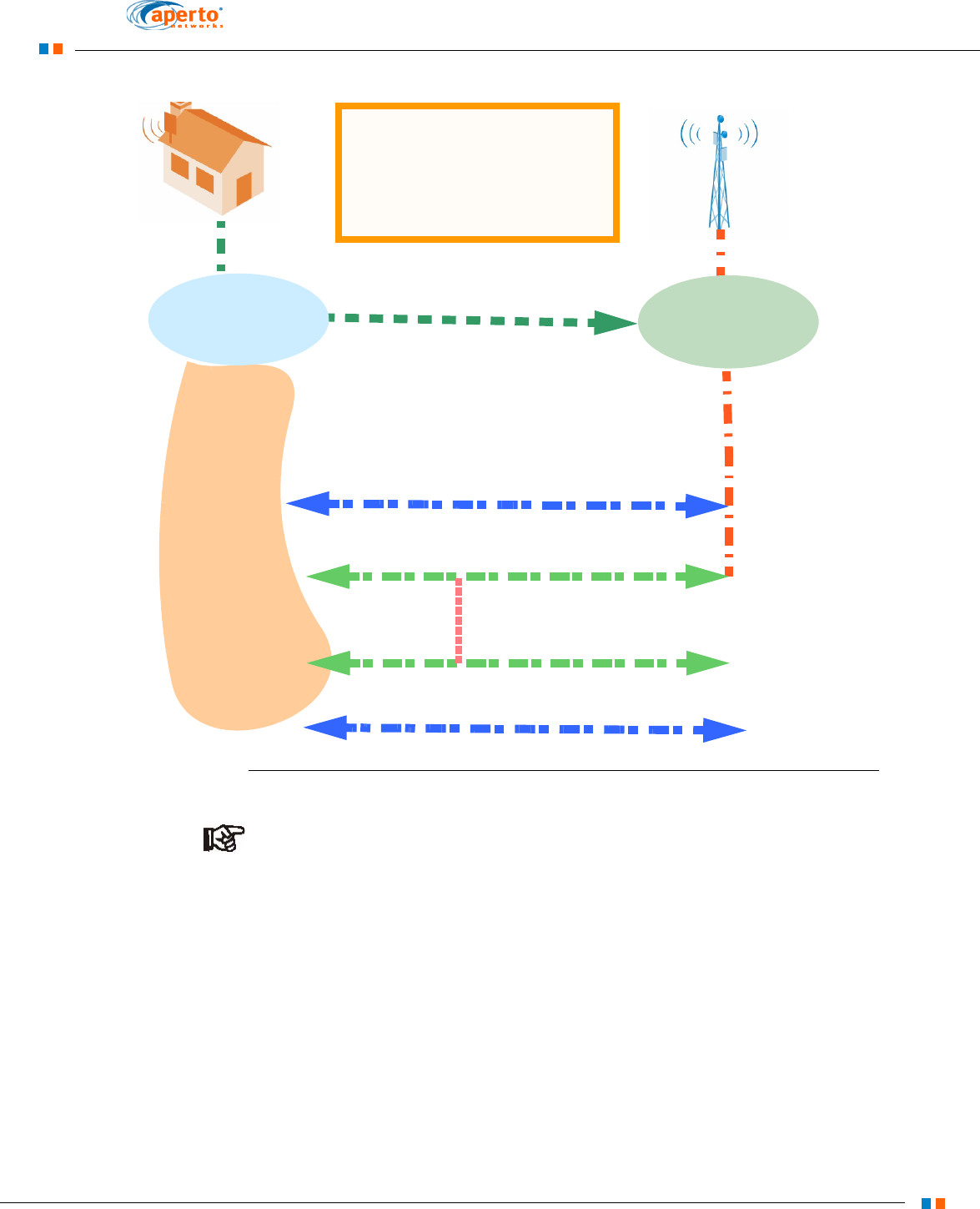
1–7
PacketMax 100/300 User Manual, 10007306, Rev J
Chapter 1. Overview Of Subscriber Station
Figure 1-2 3-DES Encryption
NOTE: TEK is encrypted using KEK derived from Authorization key and 3DES
Algorithm, while data is encrypted using TEK and DES Algorithm.
1.4.6 Certificates and Management
WiMax forum prescribes X.509 based digital-certificate for authorization process.
which is part of the negotiation process as described in the above section. The cer-
tificates are used to strengthen the security process.
The Aperto WiMax Root Certificate, is a Self-Signed certificate issued by the Aperto
Certifying Authority (CA). The CA is stored in the BS. The X.509 certificates are
injected into the base station devices at manufacturing time and can later be upgraded
from the EMS.
The Root Certificate is the same across all Base Stations and shall be available on
MSC, as the Certificate Verification happens on MSC. In the case, when primary and
redundant MSCs are installed, the Certificates need to be available on both the MSC
Authorization Key
Traffic Encryption Key
3-DES Encryption
SS uses PK to
decrypt
SS uses KEK
from AK
SS Initiates
Authorization BS validates
Certificates
Privacy Key Management — PKM
Private Key — PK
Key Encryption Key — KEK
Traffic Encryption Key — TEK
BS
SS
Traffic Encryption Key
3-DES Encryption
Authorization Key

1–8
PacketMax 100/300 User Manual, 10007306, Rev J
Chapter 1. Overview Of Subscriber Station
Cards (Primary and Redundant). Currently we are upgrading the Primary MSC with
the Wimax Root Certificate during the Upgrade Process.
1.4.6.1 Certificate Upgrades
Some important factors that users should take a note of, for certificate upgrades are:
In a redundant BS configuration, the certificates need to be installed using the
LAN upgrade tool.
Once the user has a device which is certified, the LAN upgrade and Bulk
Upgrade tool has to be used to upgrade the certificates.

2–1
PacketMax 100/300 User Manual, 10007306, Rev J
Installation of Subscriber Station
This chapter outlines the basic procedure for installing the PacketMax 100/300 Series
Subscriber Station. It identifies the minimal requirements for getting the equipment up
and running.
NOTE: It is assumed that configuration using DHCP and WaveCenter™ Con-
figuration Manager has been performed as described in the Configuring an
SS section in Chapter 4 Configuration of PacketMAX Devices of the Wave-
Center Element Management System (EMS) User Manual.
WARNING: Outdoor installation procedures should be performed by qualified pro-
fessionals following all safety and other requirements and acting in
accordance with standard practices and procedures. Failure to meet
safety requirements and/or non-standard practices and procedures
could result in personal injury and/or damage to equipment.
This chapter covers the following topics:
Installation Requirements
Installation Process
2

2–2
PacketMax 100/300 User Manual, 10007306, Rev J
Chapter 2. Installation of Subscriber Station
2.1 Installation Requirements
2.1.1 Hardware and Software Requirements
Aperto Installation Manager (AIM). AIM is a software utility that helps to config-
ure PacketMAX 100/300 devices, optimize antenna alignment, perform ping
tests, and pre-provision PacketMAX 100/300 devices for later deployment.
Laptop/desktop that has Aperto Installation Manager installed.
2.1.2 Cables and Connector Requirements
You will also need the following cables and connectors:
Shielded Cat 5 cable (outdoor rated), long enough to run between Indoor and
Outdoor Units, and two shielded RJ45 male connectors
Ethernet cable with RJ45 male connectors (straight-through for connection to
hub, or crossover for connection to computer)
Please refer to the Cable Specs for further details under section C.1.2, in Appendix C.
Table 2-1 Subscriber Site Cable Requirements
Connection Qty Cable Type Max. Length Connectors
Radio Con-
trol
1Shielded Cat 5,
Outdoor-rated
50 m (100 ft) RJ45 male
1Shielded Cat 5E,
Outdoor-rated
100 m (330 ft) RJ45 male

2–3
PacketMax 100/300 User Manual, 10007306, Rev J
Chapter 2. Installation of Subscriber Station
2.1.3 Tools requirements
You will need the following tools and supplies when installing the Subscriber Equipment:
Drill (for cable entry through walls, etc.)
Phillips screwdriver
Cabling tools
Cable tester (capable of testing 10Base-T and EIA/TIA 568B)
Cable ties, staples, or clamps for dressing cables
Silicone sealant
2.1.4 Before Installation
1. Make sure that the PM 100/300 is pre-configured using the Element Manage-
ment System (EMS) software application and then provision and configure the
unit. Generate the Subscriber Unit configuration file using Configuration Man-
ager in Element Management System (EMS) [Please refer to WaveCenter
EMS User Manual for reference]. This configuration file should be either saved
on the BS’s TFTP server, or (for local configuration mode) is already saved on
a disk and provided to the installer.
2. Make sure that the EMS software application is able to communicate with the
PM5000 or PM3000.
3. Make sure that the Aperto Installation Manager (AIM) software application is
installed on the computer (notebook) that will be used to configure and align
the PM100/300.
CAUTION: Make sure that the Indoor Unit is installed in a room with temperature
between 32 and 104 °F (0 and 40 °C) and the humidity between 10%
and 90% noncondensing.
4. Identify location for mounting the PM 100 ODU: In most cases, the unit should
be pointed at the base station with the least possible obstruction. For optimal
wireless channel performance, it is advantageous to locate the Outdoor Unit
(radio/antenna) where it has the least-obstructed path to the base station
antenna. If a line-of-site path is available, locate the Outdoor Unit where the
path is least likely to be affected by such obstructions as blowing branches,
seasonally changing foliage, etc. If a clear line-of-site path is not available,
choose a path that minimizes obstructions.
Other factors to consider when choosing a location for the Outdoor Unit include:
Distance to the Indoor Unit — Locate the Outdoor Unit so that cables to the
Indoor Unit will be within the maximum cable length limit. See Appendix E for
cable details.
Cable routing — Consider how cables from the Outdoor Unit cables will enter
the building.
Accessibility — If possible, choose a location that is relatively accessible, which
will simplify installation and any adjustment or repair that might be necessary
in the future.

2–4
PacketMax 100/300 User Manual, 10007306, Rev J
Chapter 2. Installation of Subscriber Station
5. Mounting method — The antenna/receiver includes an adjustable bracket for
mounting the unit on a pole that is 1.5 inches (3.8 cm) or 2 inches (5.1 cm) in
diameter. For other mounting options (under an eave or on a chimney, for
example), mounting hardware may be adapted as desired. Any alternate
mounting method should allow adequate adjusting of the antenna direction,
both horizontally and vertically.
2.1.4.1 Safety Requirements
Outdoor installation procedures should be performed by qualified professionals
following all safety and other requirements and acting in accordance with stan-
dard practices and procedures. Performance of non-standard practices and
procedures or failure to meet safety requirements could result in personal injury
and/or damage to equipment.
Lightning protection is recommended for subscriber equipment. Provide a ser-
vice loop for the cable. Instructions are covered in the 1-Port Power over Ethernet
Midspan User Guide.
Lightning damage is not covered by the product warranty.
WARNING: Always power OFF the PM 100/300 IDU before connecting or discon-
necting the PM 100/300 ODU.
2.2 Installation Process
Step 1. Assemble and mount the Outdoor Unit.
The Outdoor Unit (ODU) includes a rear-mounted bracket. This standard mounting
bracket allows the ODU to be mounted on a pole with a diameter of 1.5 or 2 inches
(3.8 or 5.1 cm).
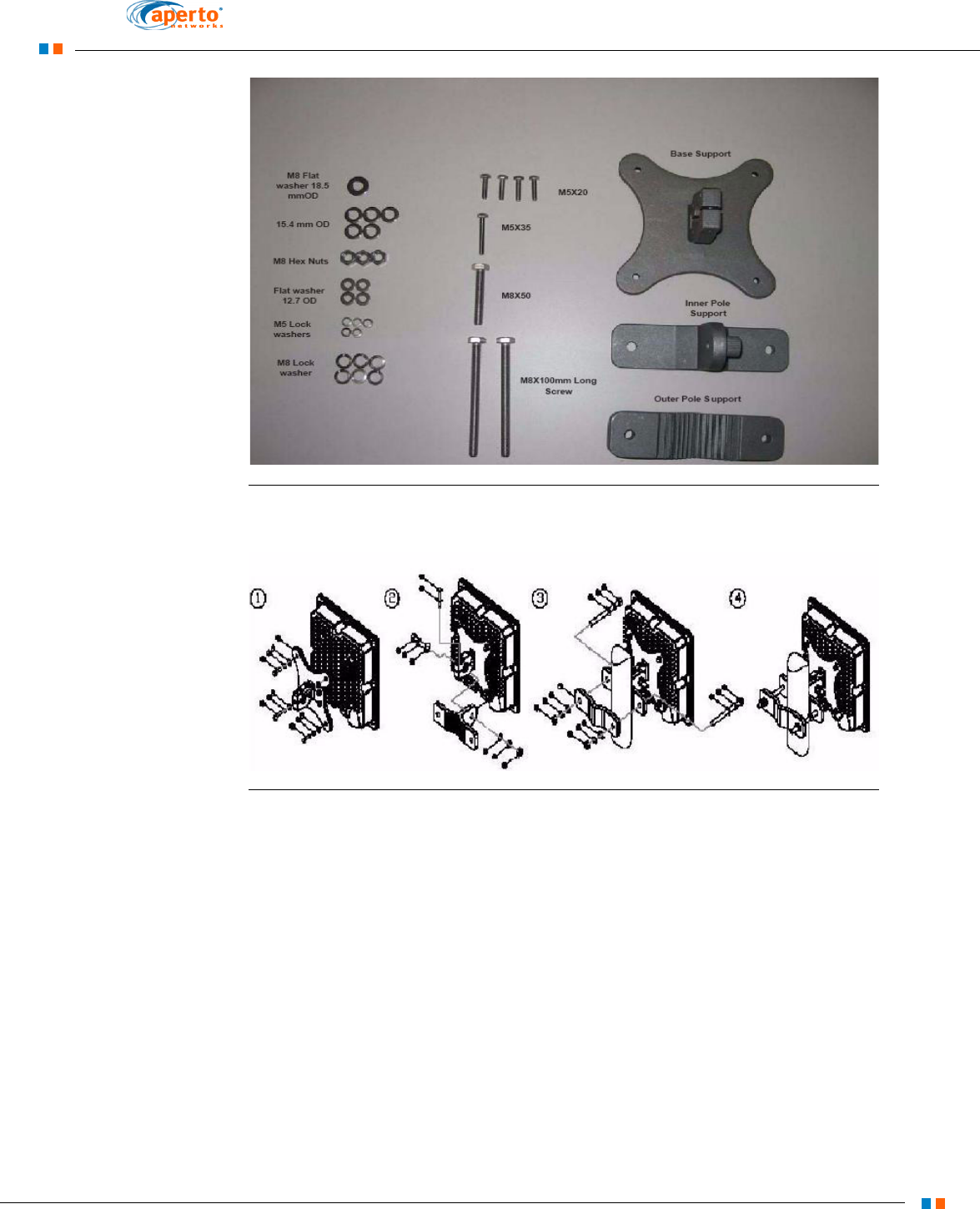
2–5
PacketMax 100/300 User Manual, 10007306, Rev J
Chapter 2. Installation of Subscriber Station
Figure 2-1 Mounting Hardware Parts
Figure 2-2 Mounting the PM 100/300-ODU
To mount an Outdoor Unit on a pole using the bracket, follow the instructions below:
1. Locate the appropriate mounting holes for the bracket on the back of the ODU.
2. Attach the mounting bracket (Base Support) to the ODU using four M5X20
screws provided. Place the Flat washers and M5 Lock washers on the Base
Support and then insert M5X20 screw. Tighten the screw. Figure 2-3 shows the
M5x20 screws securing the Base Support to an ODU.
3. Attach the Inner Pole Support and Outer Pole Support with M8X100mm Long
Screws. Place one Flat washer and one M8 Lock washer each (both ends of
the pole supports) before inserting the screw from the inner pole support to the
outer pole support. Attach a M8 Hex Nut on the other end of each M8 Long
Screw. Do not tighten the M8 Hex Nuts yet. Figure 2-4 displays a pole support
assembly.
4. Attach the Base Support on to the Inner pole support by inserting a M8x100
mm Screw. Place a Flat washer and a M8 lock washer before inserting the
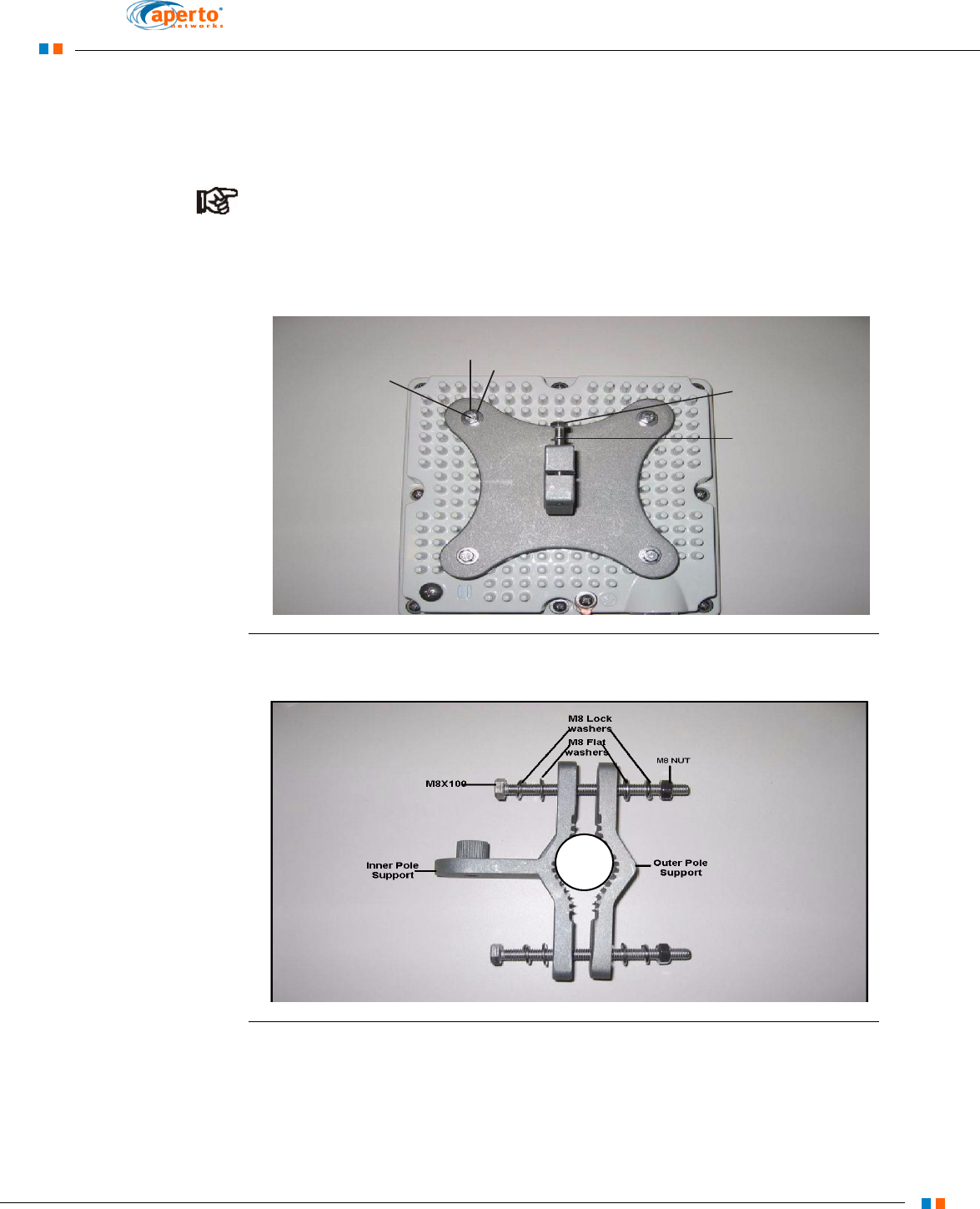
2–6
PacketMax 100/300 User Manual, 10007306, Rev J
Chapter 2. Installation of Subscriber Station
screw. Attach a Hex Nut on the other end to secure the ODU to the Inner pole
support. Figure 2-5 shows insertion of the M5x35 Screw.
5. Position the clamp around the pole in the desired location. Install and tighten
the clamp bolts enough to secure the clamp to the pole. Tighten these screw
only after antenna pointing.
NOTE: The polarization of the BS antenna should match that of the cpe.
6. Adjust the azimuth and elevation orientation of the radio/antenna as necessary
by loosening the appropriate nuts, repositioning the ODU (refer to section 1.2),
and finally tightening the nuts. Figure 2-6 shows an installed PacketMax 100.
Figure 2-3 Attaching Base Support to ODU
Figure 2-4 Pole Support Assembly
M5 Lock Washer
M5X35 Screw
M5 Lock
Washer
M5 Flat
washer
M5x20 Screw
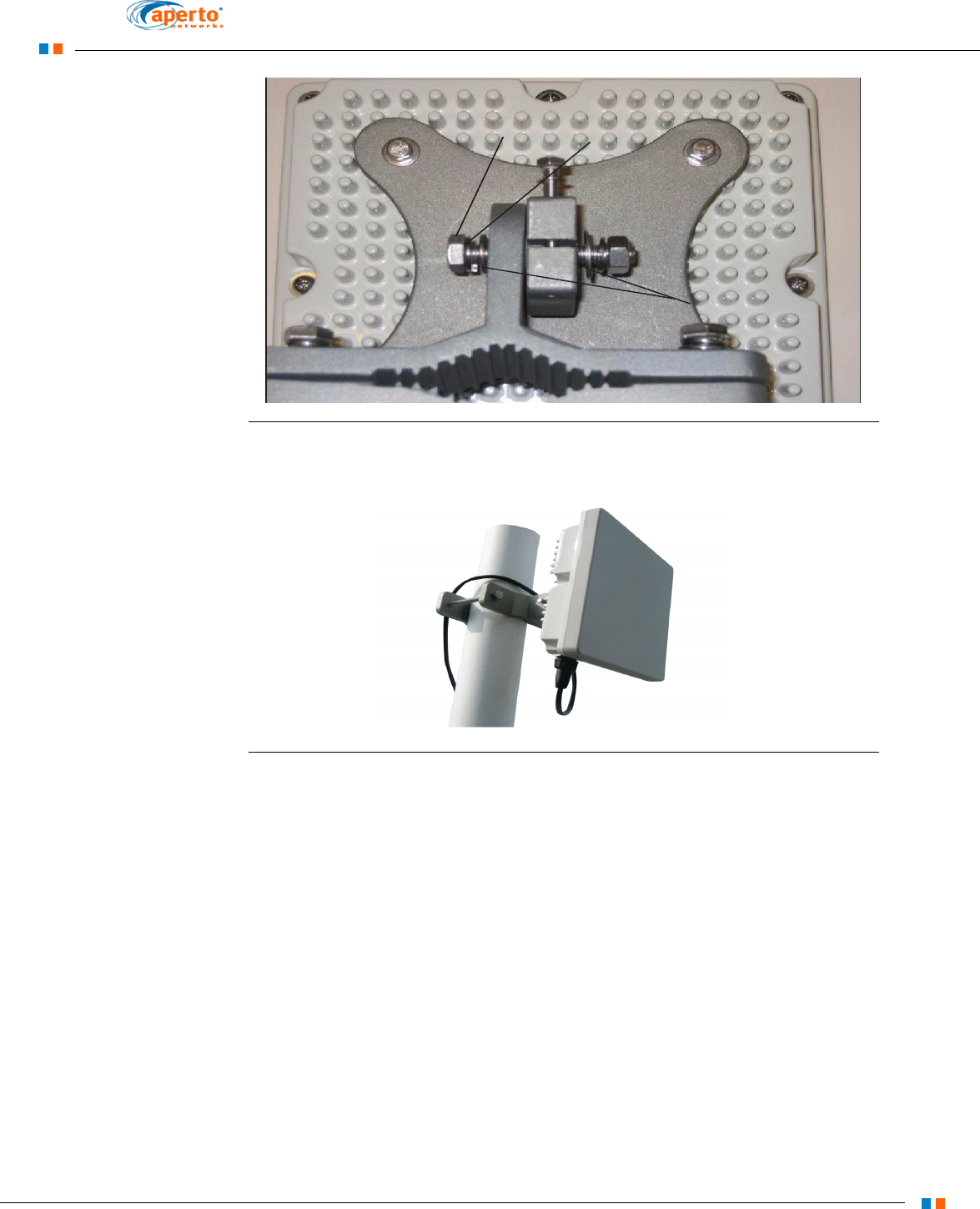
2–7
PacketMax 100/300 User Manual, 10007306, Rev J
Chapter 2. Installation of Subscriber Station
Figure 2-5 Attaching Base Support of the ODU to Inner Pole Support
Figure 2-6 Installed PacketMax 100-ODU
Step 2. Position the Outdoor Unit.
To achieve correct polarization, it is not possible to switch polarization using software.
This can be done only by making physical changes to the subscriber station installa-
tion.
Vertical Polarization
Under normal circumstances the Subscriber station will be installed in a vertical polar-
ization format. The orientation of the PM 100/300 is so that the CAT5e cable connec-
tion is located at the bottom of the PM 100/300 as can be seen in Figure 2-7.
M8X50 Screw M8 Lock
washers
M8 Flat washers
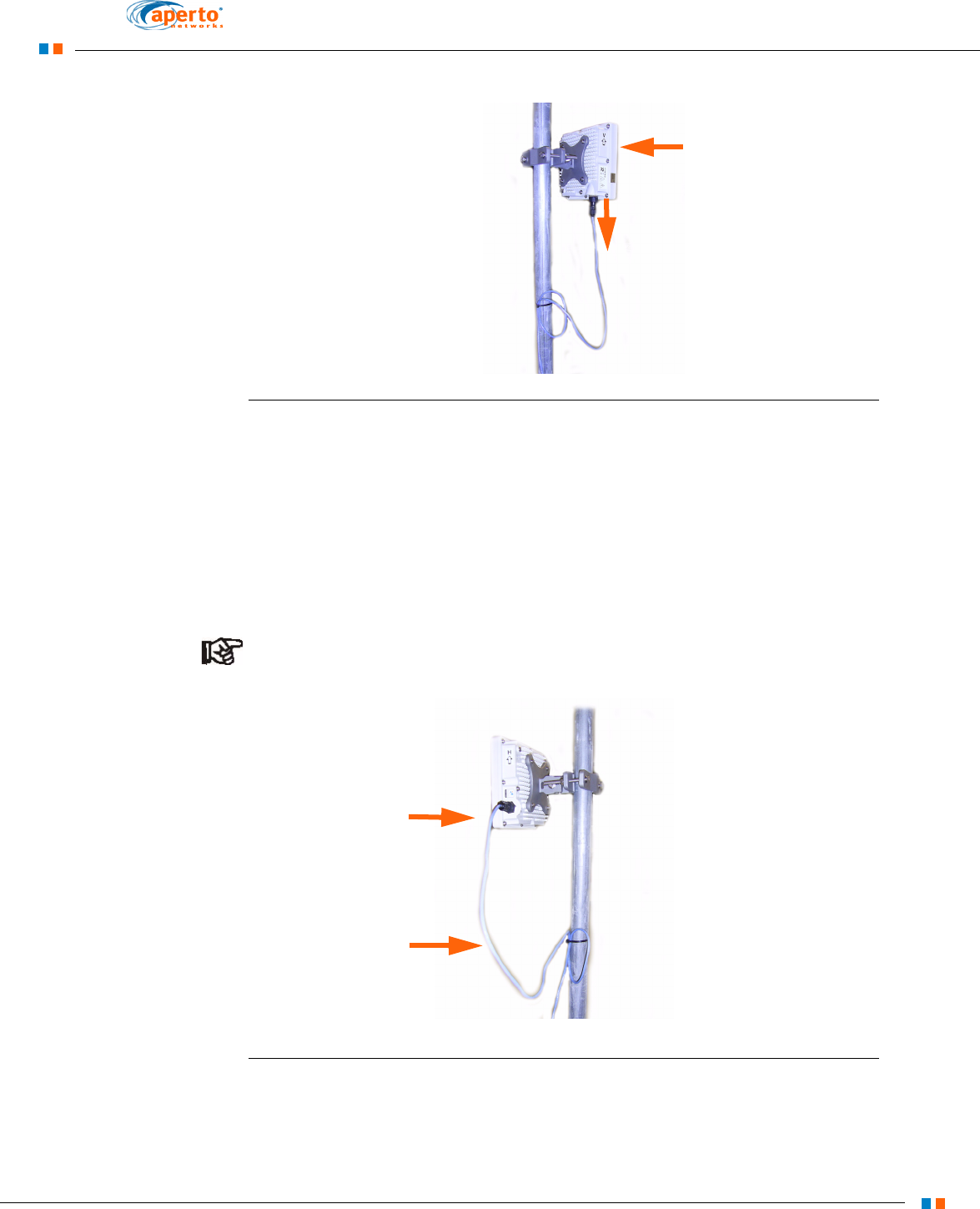
2–8
PacketMax 100/300 User Manual, 10007306, Rev J
Chapter 2. Installation of Subscriber Station
Figure 2-7 PM100/300 installed in vertical polarization (Default)
Horizontal Polarization
As the PM 100/300 only has one antenna array, in order to use horizontal polarization,
it must be turned through 90 degrees so that the antenna array can receive RF signals
that have been transmitted in a horizontal polarization (Figure 2-8). This can be
achieved when attaching the pole mounting kit so that the orientation is that the CAT5
cables are attached at the side of the PM 100/300. While PM 100/300 is in horizontal
polarization, then all the weather protection precautions must be taken.
NOTE: Please use CAT5 cover that is supplied with the PM 100.
Figure 2-8 PM100/300 installed in horizontal polarization
PM 100/300
Vertical Polarization
Loop used to reduce strain
on RJ45 connector
Horizontal
Polarization
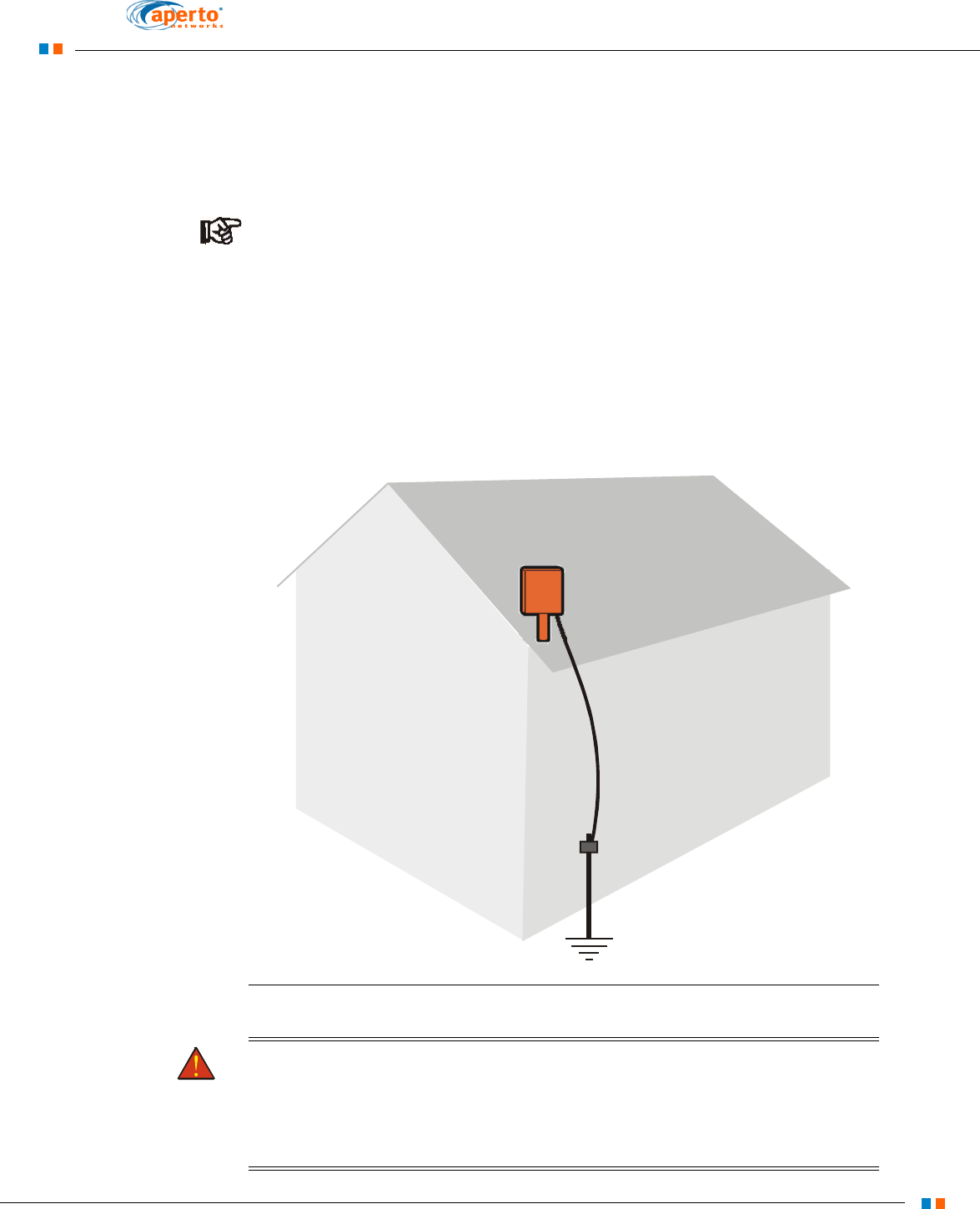
2–9
PacketMax 100/300 User Manual, 10007306, Rev J
Chapter 2. Installation of Subscriber Station
Reducing strain
No strain should be put onto the RJ45 connector of the SS otherwise it is possible
that the connection between IDU and ODU is intermittent or, in extreme cases, dam-
age to the RJ45 connector may occur. To ensure that this does not happen a loop in
the cable should introduced, as shown in Figure 2-8, so as to reduce any chance of
inflicting pressure onto the connectors.
NOTE: In Aperto WaveCenter EMS, During WSC and SS configuration, the
parameters that refer to polarization should be left at Vertical.
Step 3. Ground the Outdoor Unit (Radio/Antenna)
Grounding of the outdoor radio/antenna is an essential part of the installation process.
A proper grounding circuit is illustrated in Figure 2-9.
Figure 2-9 Grounding the Outdoor Unit (Radio/Antenna)
WARNING: Lightning protection is recommended for subscriber equipment.
Instructions and an example are contained in the document titled
Surge Protection for PacketMax Products, included on the Packet-
Max CD that accompanies the equipment. (If the CD or document
were not provided, contact Aperto Customer Service.) Lightning dam-
age is not covered by the product warranty.
Connection to
Radio/Antenna
Ground Lug
Grounding Conductor
(NEC Section 810-21)
Grounding Clamp
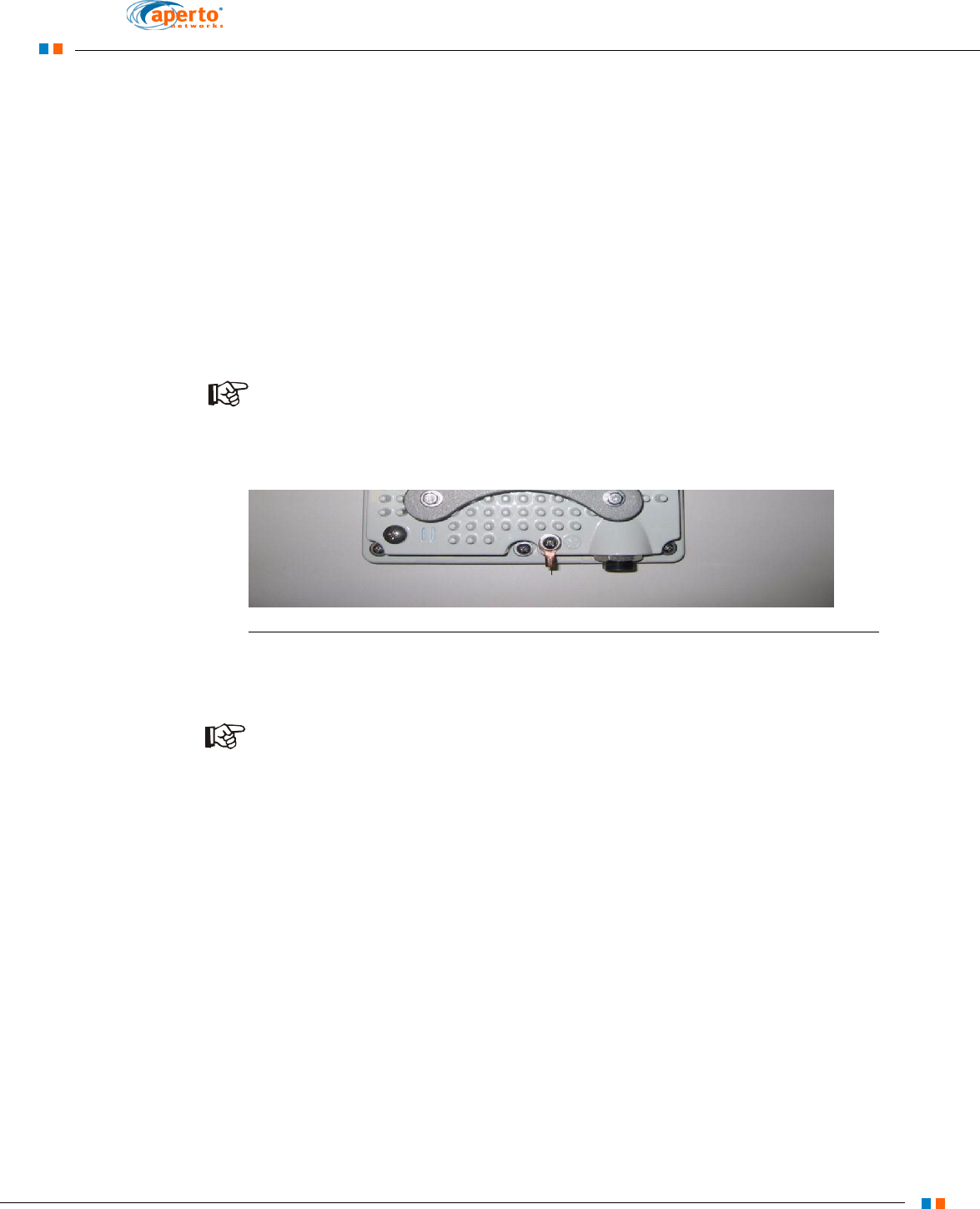
2–10
PacketMax 100/300 User Manual, 10007306, Rev J
Chapter 2. Installation of Subscriber Station
To properly ground the Outdoor Unit:
1. Locate the grounding lug on the ODU, as illustrated in Figure 2-10. The Ground-
ing lug is located on the back panel of the outdoor unit.
2. Provide a proper grounding conductor (NEC Section 810-21) long enough to
reach from the Outdoor Unit to the earth ground.
3. Crimp one end of a grounding cable to the suitable cable lug.
4. Connect the cable lug of the grounding cable to the grounding screw and
tighten the grounding the grounding screw firmly.
5. Route the other end of the grounding cable to a good ground (earth or building)
Connection. See Figure 2-11. Connect the AWG #10 grounding wire and route
to the central building ground, as shown in Figure 2-12
6. Connect the AWG #10 grounding wire and route to the grounding Bar.
NOTE: If you install a grounding electrode separate from the power service
grounding electrode system, connect the separate electrode to the grounding
system in accordance with the National Electrical Code (NEC) and local elec-
trical codes.
Figure 2-10 Location of Groundin1g Lug on Outdoor Unit (Radio/Antenna)
Refer to the table below for the grounding wire specification.
NOTE: Please do not directly connect to the lighting rod.
Copper Lug
for Grounding
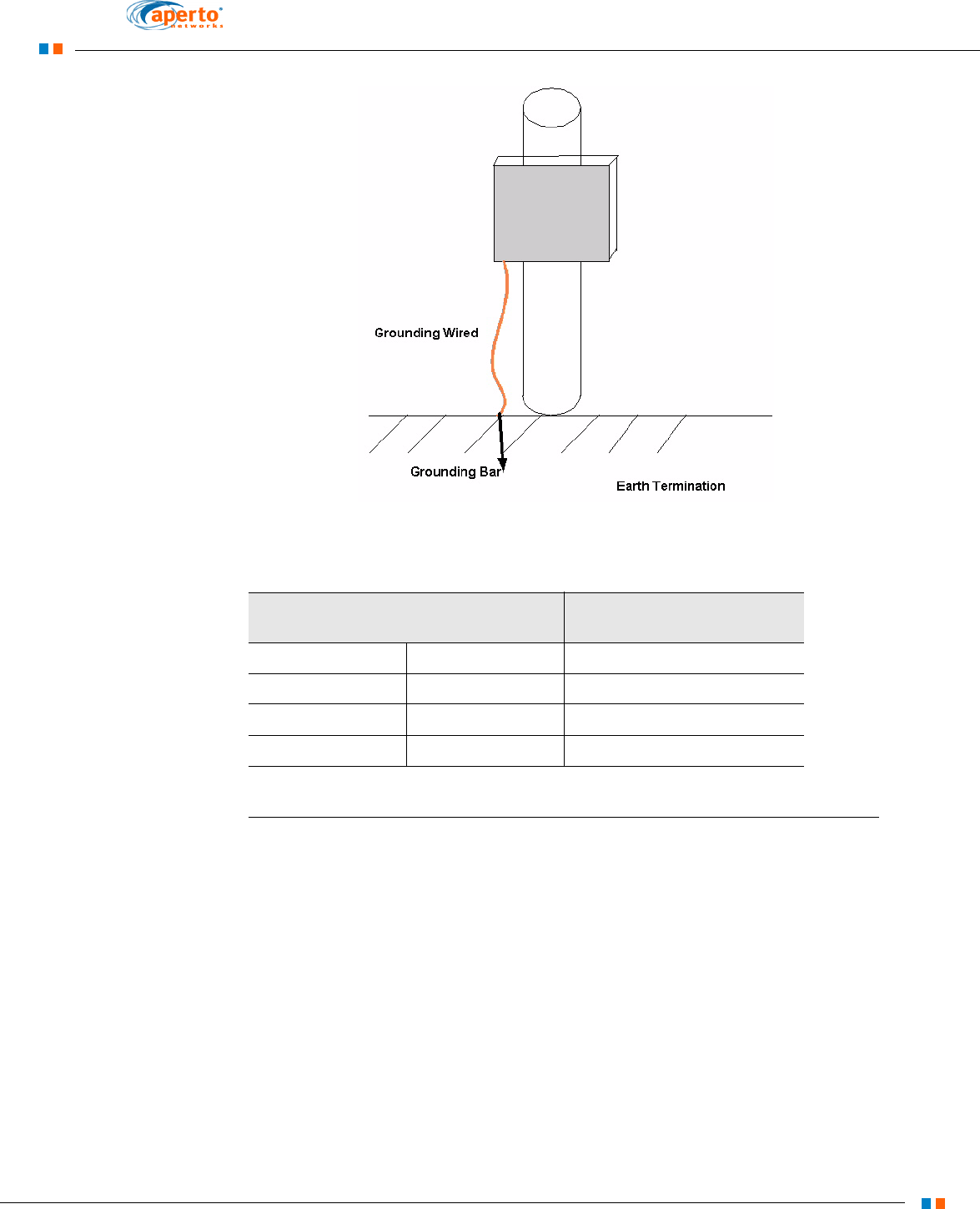
2–11
PacketMax 100/300 User Manual, 10007306, Rev J
Chapter 2. Installation of Subscriber Station
Figure 2-11 Earth Grounding
Table 2-B Grounding Wire Specifications
AWG
unit (mm)
Max length of 0.25 ohm
AWG10 2.588 65.53m
AWG8 3.264 104.24m
AWG6 4.166 141.43m
AWG4 5.189 256.03m
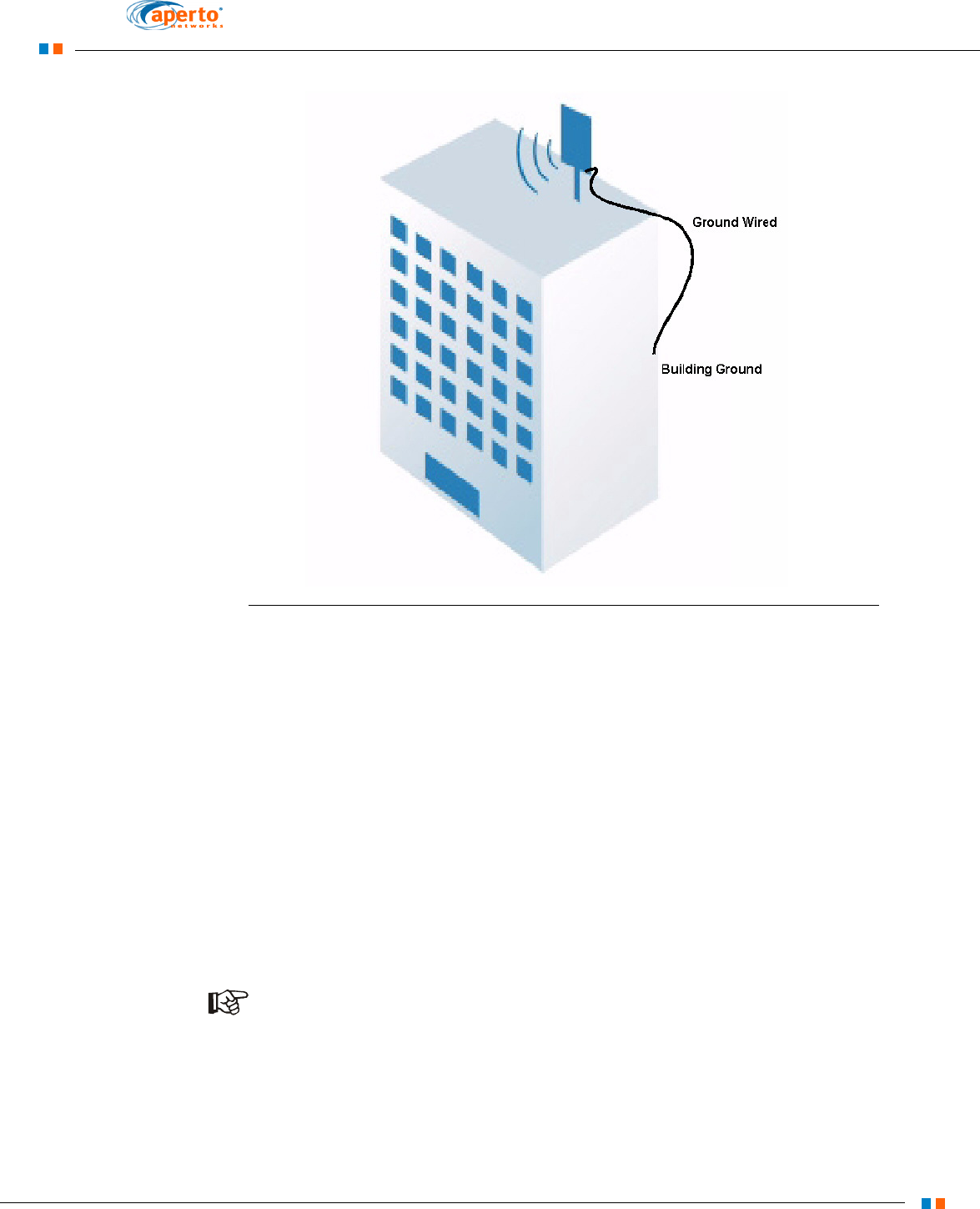
2–12
PacketMax 100/300 User Manual, 10007306, Rev J
Chapter 2. Installation of Subscriber Station
Figure 2-12 Building Grounding
Step 4. Connect the Outdoor Unit to the Power Over Ethernet
The PoE cable transports ethernet data and power and is a 1P67 compliant, weath-
erproof CAT5 cable with a rubber boot. Aperto recommends industrial CAT 5e cable
which meets the ANSI/TIA/EIA 568B.2 Category 5eStandard. In the case that the
users don’t buy this CAT 5e cable with rubber boot, Aperto recommends the use of
the rubber boot that can be used with any CAT5 cable (Please refer to Appendix for
details on installing the rubber boot).
1. Identify the location of PoE (bridge).
2. Move the Indoor Unit to its permanent location.
3. Connect the power cable (Cat-5 cable) between the Power over Ethernet and
an AC outlet (100-240 VAC).[See Appendix E for cable details, in this manual].
NOTE: It is highly recommended that the Cat-5 cable be verified using a
cable tester before connection and power-up.
4. At the Outdoor Unit, use an 1P67 compliant weatherproof cat-5 cable (pro-
vided by Aperto) to connect to the Data Out jack on the Power over Ethernet
(inside the building).
5. Connect the unit Data in jack (input) using a straight cable, to the remote Ether-
net network switch(LAN/hub switch) Patch panel or Connect the unit Data in jack
(output) to the computer, using a crossover Ethernet cable connection.
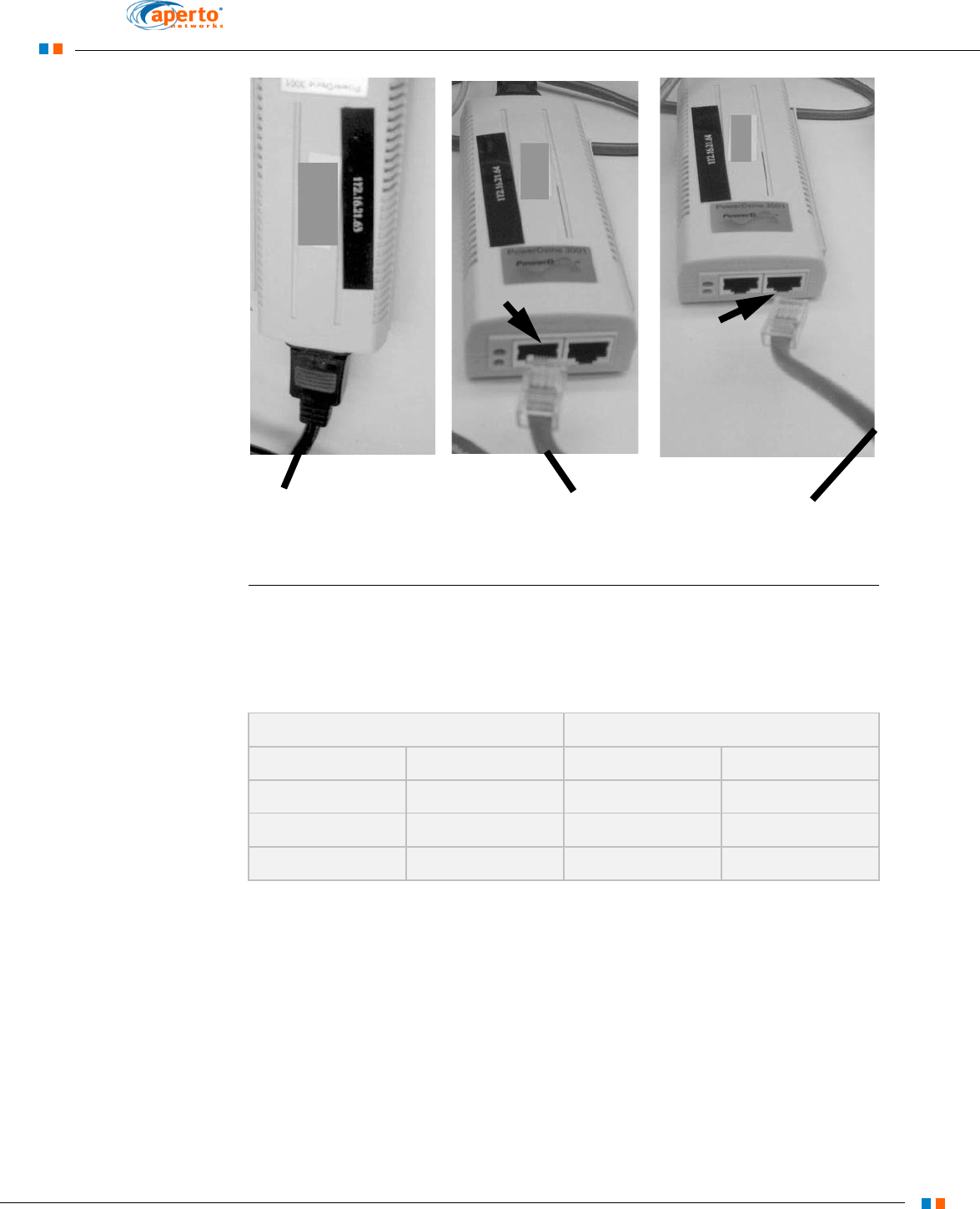
2–13
PacketMax 100/300 User Manual, 10007306, Rev J
Chapter 2. Installation of Subscriber Station
Figure 2-13 Power Over Ethernet Connections
Table 2-3 Ethernet Cable Pinouts
Step 5. Align the Outdoor Unit
There are two techniques to aid you in the CPE installation.
Using the AIM software tool. Temporarily mount the IDU close to the ODU to
facilitate a direct reading (fined-tuned alignment technique).
Using the ODU’s built-in pitch and tone capability (rough alignment technique).
Straight Cable (to Hub) Crossover Cable (to PC)
Pin 1: Tx+ Pin 1: Rc+ Pin 1: Rc+ Pin 3: Tx+
Pin 2: Tx- Pin 2: Rc- Pin 2: Rc- Pin 6: Tx
Pin 3: Rc+ Pin 3: Tx+ Pin 3: Tx+ Pin 1: Rc+
Pin 6: Rc- Pin 6: Tx- Pin 6: Tx- Pin 2: Rc-
Power cable
PoE-AC outlet
Cat 5 cable
PoE- PM 100 ODU
Cat 5 cable
PoE- PC or hub
Data Out
Data In

2–14
PacketMax 100/300 User Manual, 10007306, Rev J
Chapter 2. Installation of Subscriber Station
Aligning the Outdoor Unit Using Aperto Installation Manager (AIM)
1. Launch AIM by double-clicking the AIM destop icon. When promted, enter the
default password (isp).
2. In the Install Option window, select Setup > Next.
3. At the General tab, enter the Frequency band value (3.5 GHz, 3.3 GHz, 5.8
GHz) and WSS ports field (12 supported). If the PM 100/300 is in Server mode,
a DHCP server must be configured to provide the information for its subnet
mask, IP Address, etc.
4. Select Advanced tab. Enter BS ID, Channel Width Value, Management VLAN
ID, and Management VLAN Priority.
5. Click Next. Wait for initialization. A message box displays confirming the initial-
ization. Click Next.
6. Click the View CINR checkbox. The Buzzer checkbox is automatically selected.
Make smaller adjustments on the physical orientation of the Subscriber Station
until the highest CINR is deployed by AIM.
7. Click Finish. Wait for the PM 100/300 to initialize and for the ping test to finish.
Aligning the Outdoor Unit Using ODU’s Built-in Adio Aligment Capability
The ODU has a buzzer that generates audible beeps whose frequency and tone can
be used to help with aligning the CPE to achieve the best possible signal from the
Base Station.
Beeps become louder as the CINR improves. The beeps occur more frequently as
the RSSI (local signal strength) improves. The longest beep delay between State
changes (see table) is approximately 1 second, while the shortest delay has no delay
(constant tone). Hearing loud beeps with little delay indicates the best CINR/RSSI
positioning.
There are three tone levels associated with CINR:
>20dB (highest tone)
13.8-20dB (medium tone)
<13.8dB (lowest tone)
There are two beeping rates associated with RSSI:
-65dB (fastest rate/constant tone)
-90dB (slowest rate).
After you have reached your strongest signal, for approximately 15-30 seconds, the
tone remains in a steady state. Then the automatic alignment completes, and the fol-
lowing six states and their related number of beeps occur.
A delay/pause occurs among the following six state changes.

2–15
PacketMax 100/300 User Manual, 10007306, Rev J
Chapter 2. Installation of Subscriber Station
NOTE: The above-listed states will not beep until you click the Next button
at the CINR screen (AIM).
Step 6. Reboot the subscriber station and connect to the PacketMAX network
The EMS is the connection to the PacketMax network. When the Subscriber Unit
reboots at the end of the installation/antenna alignment process described above, it
performs an initialization procedure that brings it up as part of the PacketMax network.
During this procedure:
The Subscriber Unit requests an IP address from the system’s DHCP server.
(The DHCP request is passed along by the BS’s DHCP relay agent.)
The DHCP server responds with the IP address and other information, includ-
ing the name of the Subscriber Unit’s configuration file. The Base Station Unit
and the Subscriber Unit both learn the new IP address.
The Subscriber Unit downloads its configuration file (as previously created
using the WaveCenter Configuration Manager) from the TFTP server.
The Subscriber Unit configures itself according to the received configuration file
and activates for subscriber traffic.
Table 2-4 Audio Alignment
States No. of Beeps
Wait for sync 1
Wait for uplink parameters 2
Wait for link establishment 3
SBC request sent 4
Reg Req Sent 6
Establish Prov Connection 10

2–16
PacketMax 100/300 User Manual, 10007306, Rev J
Chapter 2. Installation of Subscriber Station

3–1
PacketMax 100/300 User Manual, 10007306, Rev J
Aperto Installation Manager
This chapter provides instructions for using the Aperto Installation Manager (AIM) util-
ity. The AIM can be used to perform any of the following functions:
Initially configure the PacketMax 100/300 and optimize antenna alignment.
Re-align the antenna of a previously-installed PacketMax 100/300.
View wireless link status.
Perform ping tests of the wireless link between the PacketMax 100/300 and the
base station.
Pre-provision (pre-configure) a PacketMax 100/300 for later installation.
This chapter covers the following topics:
Aperto Installation Manager Requirements
Installing the AIM Software on the PC
Connecting to the PacketMax 100
Working with the Aperto Installation Manager
Aperto Installation Manager Troubleshooting
Buzzer in AIM
NOTE: The instructions and screenshots in this chapter showing PacketMax
100 applies to PacketMax 300 as well. Please ensure that the correct model
number is chosen during AIM installation
3

3–2
PacketMax 100/300 User Manual, 10007306, Rev J
Chapter 3. Aperto Installation Manager
3.1 Aperto Installation Manager Requirements
The Aperto Installation Manager is a software utility which uses graphs of signal
strength and signal-to-noise ratio to identify the best direction for the subscriber
antenna to be pointed. It runs on PCs meeting the following requirements:
Operating System: MS Windows 98/2000 Professional, and Linux.
Minimum of 128 MB RAM
Java Runtime Environment (JRE 1.5)
Ethernet port
NOTE: Aperto recommends a laptop PC with 256 MB RAM, 10 GB disk drive,
Pentium processor, and Ethernet LAN connection. Systems as small as 128
MB RAM and a 386 processor have been used, but their performance is not
satisfactory.
The PC connects to the Indoor Unit through the Ethernet port. Radio signal and con-
trol cables must connect the Indoor Unit to the Outdoor Unit.
Also, when you run AIM, ensure the following:
A cross over cable is used
The PC/laptop has static IP address
There is no firewall
3.2 Installing the AIM Software on the PC
To install Aperto Installation Manager
1. Obtain the PacketMax CD distributed with your PacketMax Series 100 equip-
ment, which includes the PacketMax Aperto Installation Manager (AIM) soft-
ware plus Java software from SUN Microsystems.
2. If the Java Runtime Environment is not present on the PC, install it from the
PacketMax CD (bs/Software/Application/Support directory) or the java.sun.com
web site.
3. Install the Aperto Installation Manager (AIM) software by running the file
setup.exe from the \Customer_CD\WaveCenter EMS Pro 1.1\Software\Installation
Manager\ directory of the PacketMax CD. At the end of this installation, an AIM
icon will be placed on the Windows desktop.
3.3 Connecting to the PacketMax 100
Please refer to Chapter 1 for Installation of PM 100/300 and pinout connections for
the cables used in AIM.
To connect AIM with PacketMAX 100/300
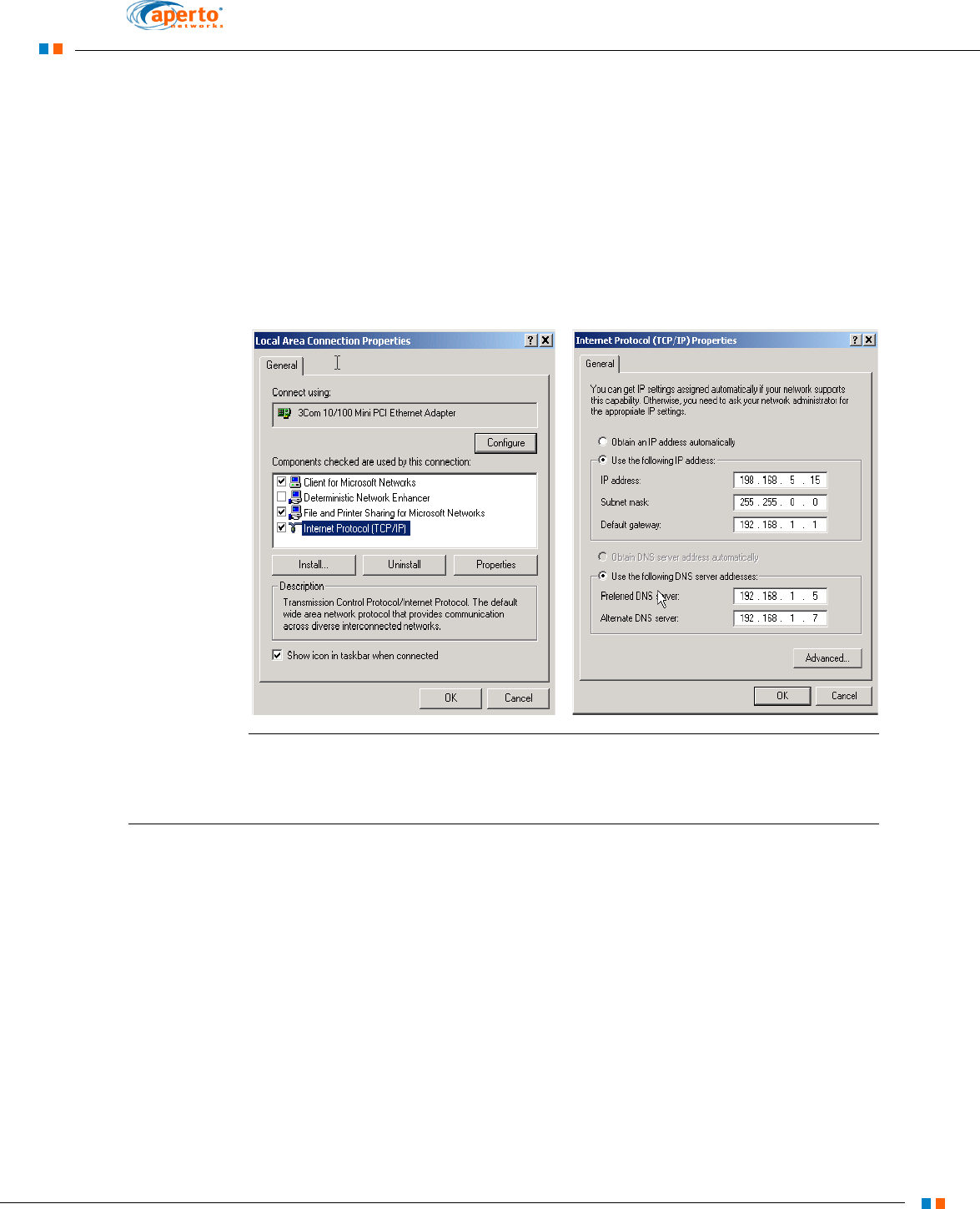
3–3
PacketMax 100/300 User Manual, 10007306, Rev J
Chapter 3. Aperto Installation Manager
1. Ensure that the Interface Box is connected to the Outdoor Unit as described
under Connecting the ODU to the Interface Box section.
2. Connect the computer to the Interface Box LAN port using a crossover Ethernet
cable.
3. Ensure that there is only one active Ethernet interface on the computer. (If there
are multiple active Ethernet interfaces, the AIM cannot determine which to use.)
4. Ensure that the computer has a fixed IP address, and not one set by a DHCP
server. Figure 3-1 gives an example of setting a fixed IP address on Windows
2000; be sure to select Use the following IP address. It does not matter what
IP address, network mask, and gateway are used.
Figure 3-1 Windows 2000 IP Address Setting
3.4 Working with the Aperto Installation Manager
3.4.1 Logging into Aperto Installation Manager
To log into AIM
1. Double-click on the Aperto Installation Manager icon on the PC’s desktop. This
will cause the Authentication window to be displayed, as shown in Figure 3-2.
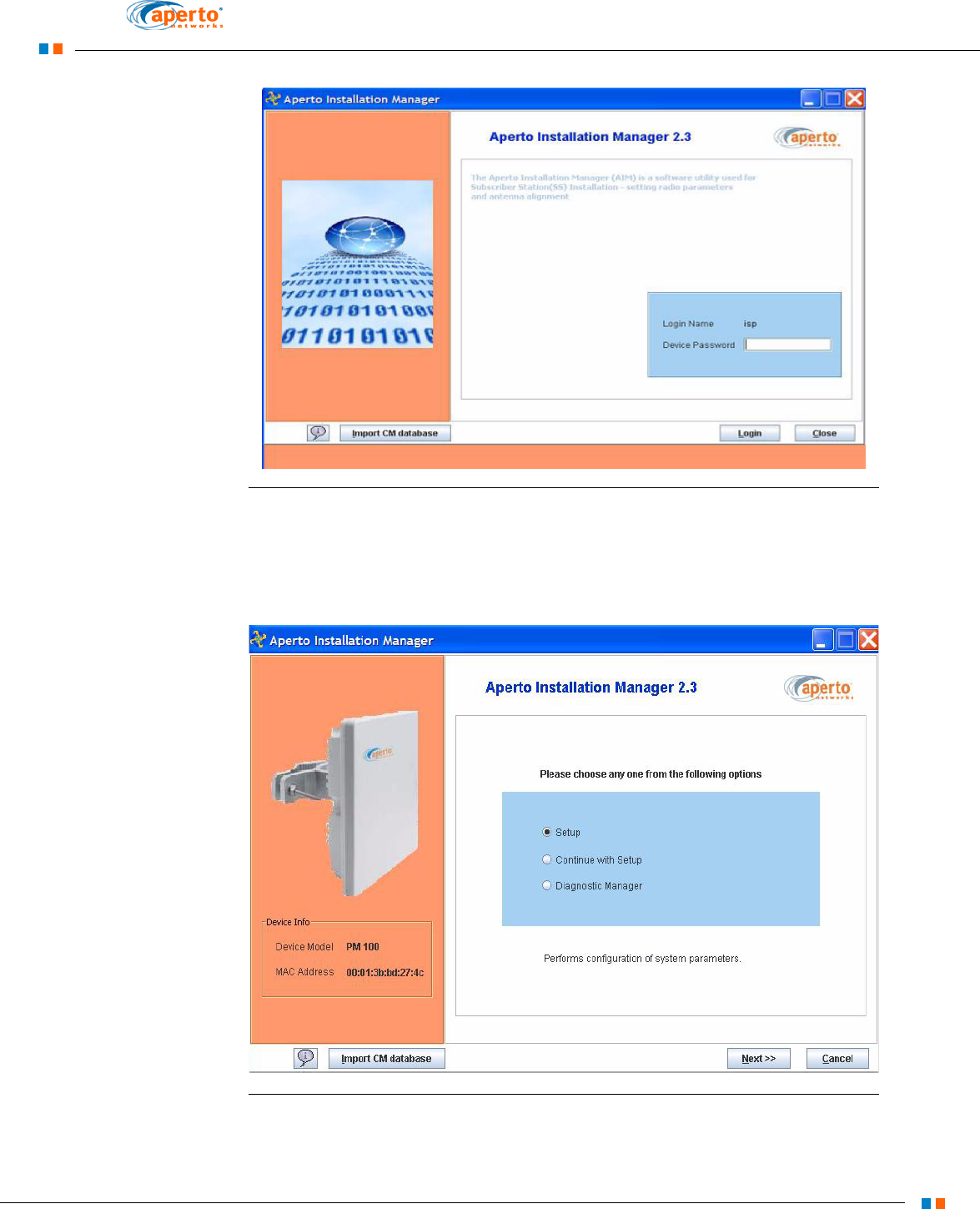
3–4
PacketMax 100/300 User Manual, 10007306, Rev J
Chapter 3. Aperto Installation Manager
Figure 3-2 AIM Login Window
2. Enter the AIM login name and password and click Login. The default login
name and password is isp.
Once you are logged in, the AIM main window is displayed as shown below:
Figure 3-3 AIM Main Window

3–5
PacketMax 100/300 User Manual, 10007306, Rev J
Chapter 3. Aperto Installation Manager
3.4.2 AIM Options
The main AIM window lists the following four options:
Import CM Database: Allows the BS xx.DAT file to be copied from the computer
to the PacketMAX device.
Setup: Provides basic configuration, antenna alignment, and throughput test-
ing.
Continue with Setup: Allows to align antenna when basic configuration has
already been completed.
Diagnostic Manager:
3.4.3 Importing the BS XX.DAT File
When BS configuration is performed using the Server Configuration Tool in Element
Management System (EMS) the xx.DAT (where “xx” is the specific BS name) database
file is generated. This file records basic parameters for all configured BSs:
BS name
Sector name
Channel width
Channel frequency
Broadcast polarization
BS diversity
CINR ratio
Frequency band
The Configuration Manager has an option to copy the data file to a diskette.
The Installation Manager allows the data (xx.DAT) file to be downloaded from the com-
puter to the PacketMax 100. The PacketMax 100 will then load all of its configuration
parameters automatically from the xx.DAT file once the SS’s BS and sector are
selected.
To download the xx.DAT file to the PacketMax 100:
1. Click on the Import CM database button on the main screen of the Aperto
Installation Manager.
2. Choose the file and click on Open. A successfully imported dialog box shows
up
3.4.4 Basic Configuration
1. In the Install Option window, select Setup; then click on the Next>> button. The
Configuration Window will be displayed, as shown in Figure 3-5. The Configu-
ration Window shows the configuration retrieved from the PacketMax 100. The
MAC address should be the same as recorded on the label on the unit.
NOTE: If the data file has been downloaded as described under Downloading
the BS.DAT file section below, the only parameters you need to configure are
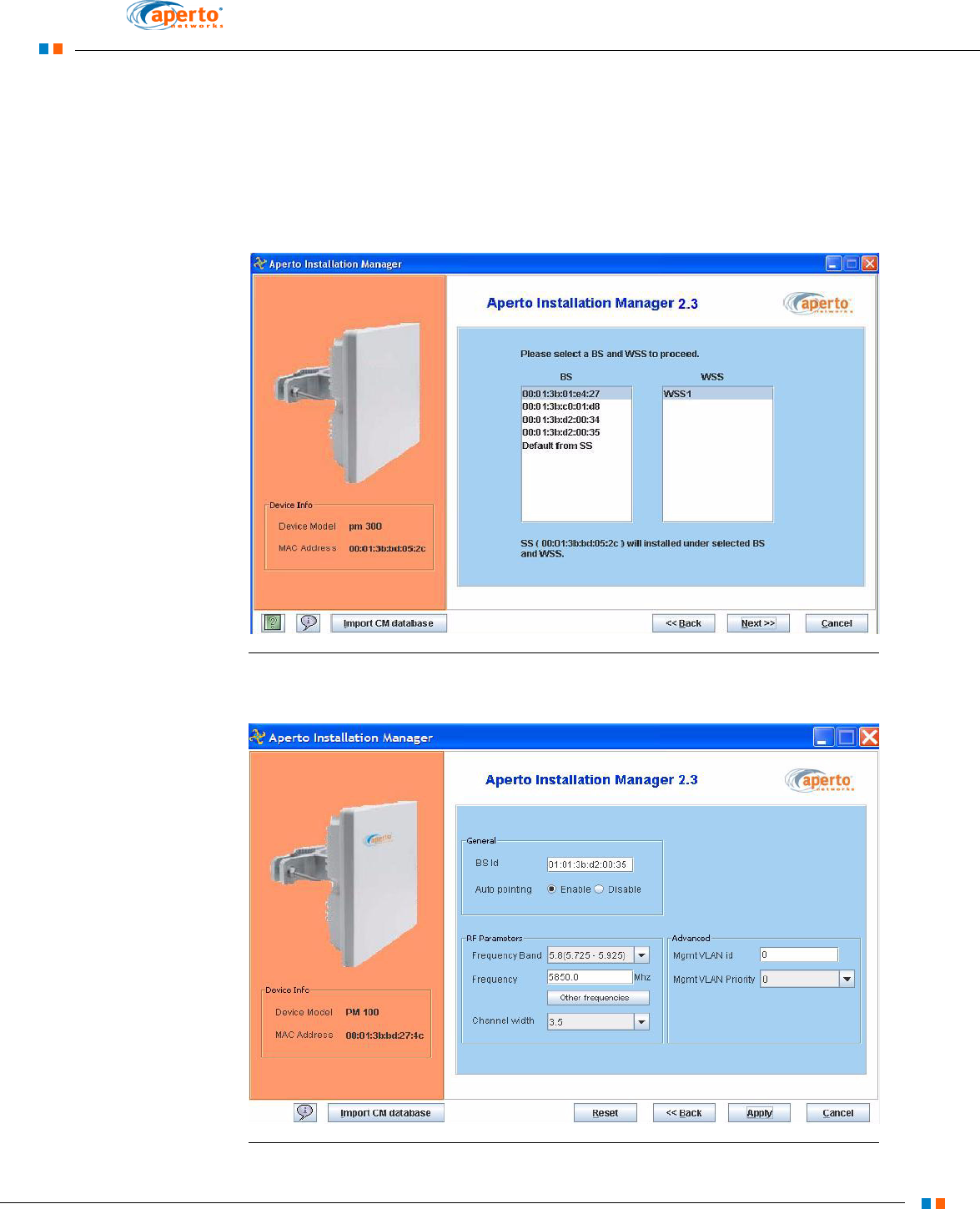
3–6
PacketMax 100/300 User Manual, 10007306, Rev J
Chapter 3. Aperto Installation Manager
the BS’s WSS number and the BS ID (name); the others will be determined
automatically using the BS.DAT file. Steps 2 to 3 may be skipped.
2. In the Configuration Window, if a configuration file has been imported then a
different screen will show up, as in Figure 3-4. If a file has not been imported
earlier, select the frequency band of the wireless link from the drop-down menu,
as in Figure 3-5. (This selection must match the frequency band of the Packet-
Max 5000.)
Figure 3-4 BS and WSS selection
.
Figure 3-5 Configuration Window: General

3–7
PacketMax 100/300 User Manual, 10007306, Rev J
Chapter 3. Aperto Installation Manager
NOTE: The frequency band of PacketMax 100 is 3.5 GHz, by default. It is
important to note this difference when configuring the frequency band in a
Base Station and Access Point. If units of both types are to be used within a
sector, the frequency band must be compatible with the range of both
devices.
3. In the BS ID field, enter the name of the PacketMax 100’s Base Station Unit,
as specified in the configuration of the BS. Remember that the BS ID is case-sen-
sitive.
CAUTION: Since the BS and SS both use the BS name and wireless port in the
signal scrambling algorithm, the BS and SS will not be able to com-
municate if the BS name is not entered correctly.
4. In the Frequency (MHz) field, select the center frequency for the wireless link
from the pull-down menu. 3.3, 3.5 and 5.8 GHz are supported.
NOTE: You will need to determine an appropriate center frequency prior to
performing this configuration. Aperto has no way of suggesting a default
value appropriate to your area. As soon as you finish configuring the Pack-
etMax 100, it will begin transmitting on the selected frequency.
NOTE: PM 5000 should be configured in Server mode and receive their IP
address and configuration information from a EMS server. The Aperto equip-
ments should be configured with infinite leases. This is appropriate since the
same IP address should not be given to another device in the network.
5. If Automatic Frequency Selection (AFS) is desired, you can click on the Other
Frequencies button to open the AFS Frequencies window shown in Figure 3-6.
AFS will be enabled if you specify at least one alternate frequency.
CAUTION: Enabling AFS during initial setup using the AIM will mean that the
PacketMax 100 will be likely to switch frequencies every 2 minutes
during antenna alignment, making the procedure very difficult.
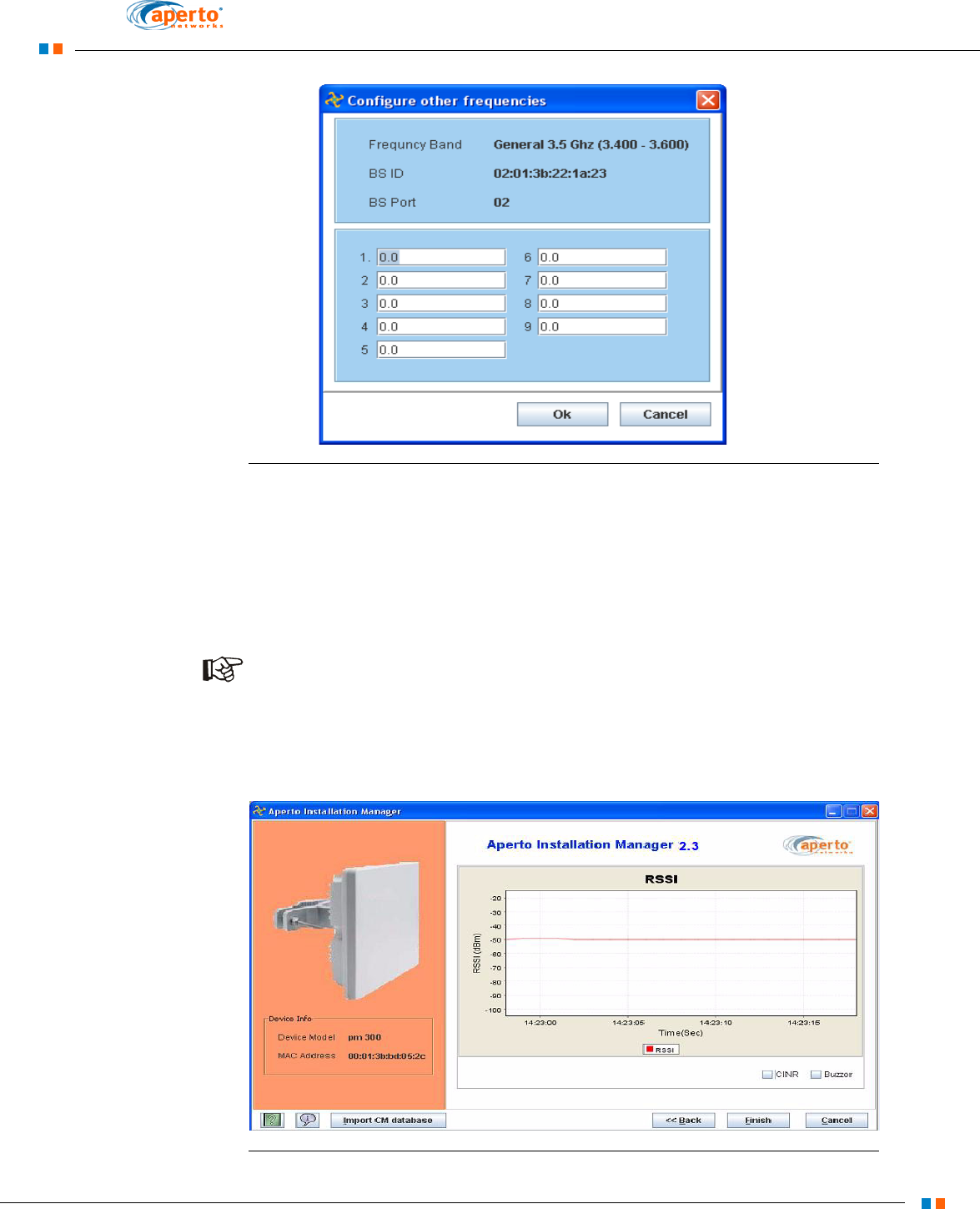
3–8
PacketMax 100/300 User Manual, 10007306, Rev J
Chapter 3. Aperto Installation Manager
Figure 3-6 Configure Other Frequencies Window
6. Use the drop-down menu to select the Channel Width. If you are unsure, stick
with the default selection. 3.0, 3.5, 5.0, 5.5 and 7.0 MHz are supported.
7. For VLAN applications, specify the Management VLAN ID and Management
VLAN priority. Usually, the Management VLAN ID should be the same for the SS
and BS. If you leave the value at the default of 0, the SS will automatically learn and
use the BS’s Management VLAN ID.
NOTE: VLAN configuration is performed primarily using the Configuration
Manager. Only the VLAN management ID and priority can be set locally using
the AIM.
8. When the restart is finished, the AIM will go into antenna alignment mode, dis-
playing the Alignment Window shown in Figure 3-7.
Figure 3-7 Alignment Window

3–9
PacketMax 100/300 User Manual, 10007306, Rev J
Chapter 3. Aperto Installation Manager
3.4.5 Aligning the Antenna
To align the antenna, perform the steps in this section.
1. While viewing the graph shown in Figure 3-7, move the antenna to maximize
the signal strength as shown on the graph. For 3.5 MHz channel bandwidth,
values greater than -92.1 dBm will work in QPSK -1/2. Values greater than -
86.6 dBm will work in 16QAM -1/2. Also, values greater than -77.1 will work in
64 QAM -1/2.
If the signal does not move up from the bottom of the Local Signal Strength graph
(i.e., shows -100 dBm), do the following:
• Verify that the frequency and BS ID were correctly configured.
• If the link has line-of-sight between the antennas, you should know the
general direction to align the antenna. Start in that direction. Move the
antenna every few seconds until the Local Signal Strength line rises at
lease once. Once it rises, slow the movement of the antenna. If the Signal
Indicator line has not risen after 2 to 3 minutes, it is best to click the Pre-
vious and then the Next buttons to reset sequence.
• If the installation is not line-of-sight, either search for a first synchronization
(as indicated by the rise of the Signal Indicator line) or just pick a direction
to align the antenna.
2. Once the Local Signal Strength value is maximized, click on the View CINR
button to display the full window as shown in Figure 3-8. To achieve a link
16QAM 1/2 or better, make sure the receive signal level is -87 dBm and the
CINR is greater than 8dBm.
Aperto products have adaptive modulation and error correction. As data is transferred
and high CINR is achieved, the system will automatically adjust to the highest modu-
altion (64QAM 3/4).
AIM automatically transfers data following antenna alignment and reports the through-
put values attained, which will be less than actual since the system is adjusting for
the best throughput values.
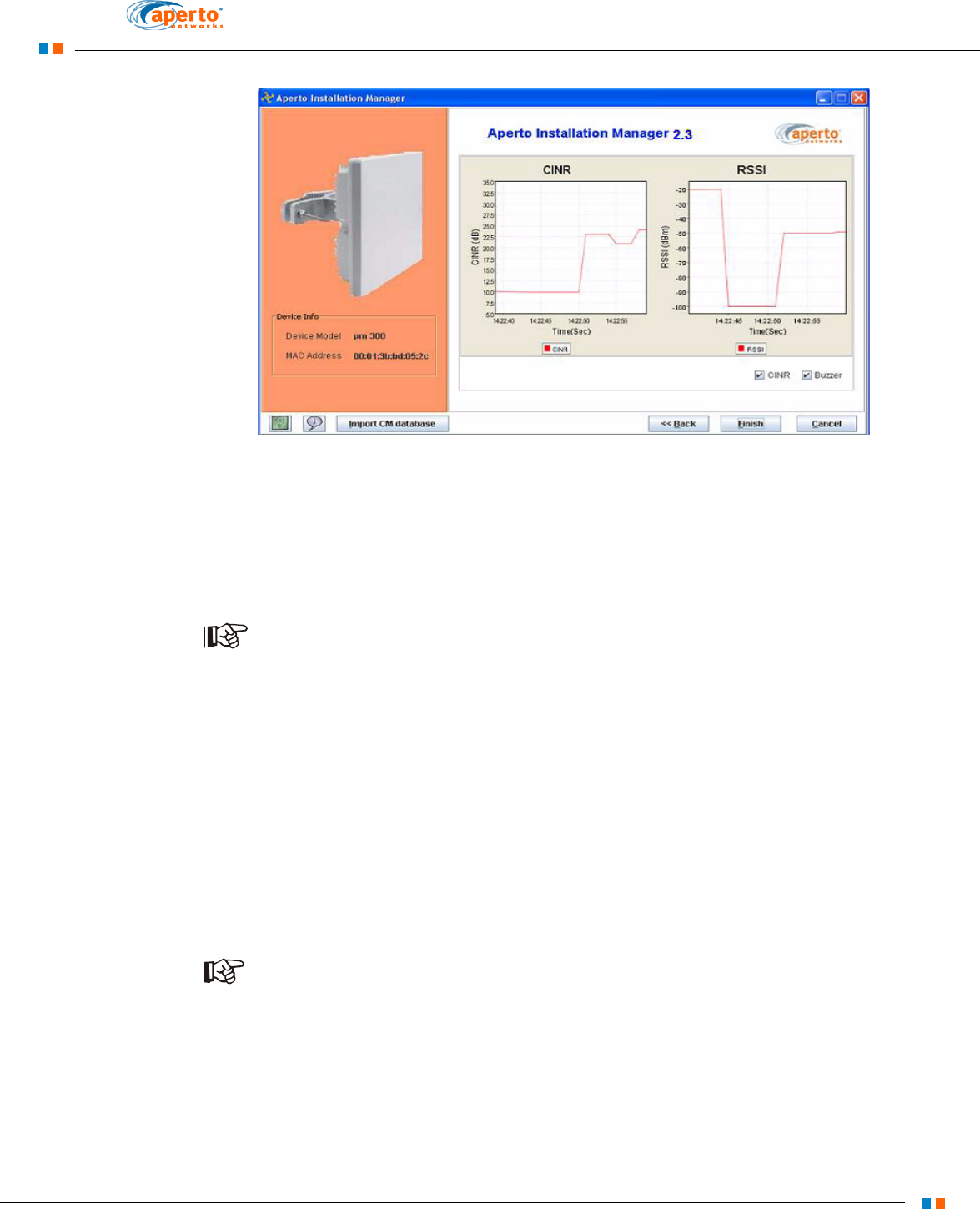
3–10
PacketMax 100/300 User Manual, 10007306, Rev J
Chapter 3. Aperto Installation Manager
Figure 3-8 Alignment Window with CINR Graph
3. Adjust the antenna again until the Local Signal Strength and CINR are the best
you can get.
4. Click on the Finish button in the Alignment window. A series of pop-up win-
dows will display, showing the progress of the application. Figure 3-13 shows
the Installation Results Window.
NOTE: .In scanning mode of AIM, the Subscriber Unit also adjusts the syn-
chronization. The synchronization is necessary to match that of the Base Sta-
tion. It is normally carried in the wireless frame. Since it is possible that the
SS has not yet found the appropriate signal as it is scanning, it is also pos-
sible that the synchronization adjustment may be misaligned. To ensure
proper antenna alignment, do not spend more than 10 minutes in the align-
ment phase of AIM. Use the previous and next buttons to restart the process
at least every 10 minutes.
5. It is important to check the RF and IP transmission results to see if you have
the best possible wireless connection. If the results are not acceptable, perform
the steps described under Re-aligning the Antenna (Continue with Setup Mode) to
repeat the alignment process.
6. If you are ready to close the AIM, click on the Done button of the Installation
Results window. The AIM will prompt for confirmation that you really want to
exit.
NOTE: Aperto Installation Manager (AIM) performs radio checks following
the antenna alignment. This will allow the installer to check radio cables dur-
ing alignment testing if no signal or a weak signal is being shown on the align-
ment screen. This may cause confusion in detecting the difference between
a radio not properly connected and no coverage. Click on the finish button
from the antenna alignment screen, if in any doubt. The radio will be checked
and the user will be informed about the radio connectivity.

3–11
PacketMax 100/300 User Manual, 10007306, Rev J
Chapter 3. Aperto Installation Manager
3.4.6 Re-aligning the Antenna (Continue with Setup Mode)
The Continue with Setup option on the Install Option window provides direct access
to the antenna alignment function (Alignment page) without going through the config-
uration steps.
To align the antenna using the Continue with Setup mode:
1. Go to the Install Option window (Figure 3-4) and select Continue with Setup and
click Next. The Subscriber Station reboots and the AIM displays the Alignment
Window, as shown in Figure 3-7.
2. Perform the steps under Aligning the Antenna.

3–12
PacketMax 100/300 User Manual, 10007306, Rev J
Chapter 3. Aperto Installation Manager
3.5 Aperto Installation Manager Troubleshooting
This section offers solutions for problems related to the use of the Aperto Installation
Manager (AIM) utility.
3.5.1 Problems Connecting to the Subscriber Unit
If the Aperto Installation Manager fails to connect with the PacketMax 100 after MAC
address/frequency configuration, a “Host unreachable” message will result. Possi-
ble causes and solutions include the following:
Cabling problem — Verify that a crossover cable is being used, and that it is
securely connected at both ends.
Incorrect MAC address — Check the MAC address entered against the MAC
address on the PacketMax 100, and correct if necessary.
Computer does not have fixed IP addresses — On the computer running the
AIM, ensure that the Ethernet connection is configured with a fixed IP address,
subnet mask, and gateway.
Multiple Ethernet connections enabled — On the computer running the AIM,
verify that only the Ethernet connection to the PacketMax 100 is enabled. If
multiple Ethernet connections are enabled, the AIM will not be able to deter-
mine the correct connection to use.
Another application using the port — Close any application that might be using
the computer port employed by the AIM. Use the Windows task manager or
LINUX/UNIX process status as appropriate, and remove the task or reboot the
computer as necessary. (Sometimes Windows will have an extra Java task that
is using the port.)
3.5.2 Problems Communicating with the Base Station Unit
After antenna alignment is finished, the Aperto Installation Manager (AIM) establishes
communication with the Base Station Unit, downloads configuration and IP informa-
tion, and performs ping and throughput tests with the Base Station Unit. The SS state
during establishment of the communication link and initialization of the SS is indicated
by messages in a pop-up window. If the Aperto Installation Manager hangs at a par-
ticular state, that state will help identify the nature of the problem.
If establishment of the communication link and initialization of the SS succeed, but the
ping and throughput tests are not successfully completed, the Aperto Installation Man-
ager indicates installation failure in the Results Window.
Possible causes and solutions for a failure in communication with the Base Station
Unit include the following:
Incorrect frequency entered — Verify that the frequency information specified
for the SS matches the BS. (Typically, the AIM will have hung at the “searching
for sync” or “link establishment” state.)
Incorrect BS ID entered — Verify the BS ID, which is case-sensitive and must
match the ID as entered on the BS.

3–13
PacketMax 100/300 User Manual, 10007306, Rev J
Chapter 3. Aperto Installation Manager
Incorrect WSS port number entered — Verify that the SS is in the correct sector
and that the correct port number is being used.
Cable problems — Ensure that the signal and control cables between the Inter-
face Box and the Outdoor Unit are properly and securely connected; that
cables meet the requirements given in this manual; and that cables do not
exceed 100 m (330 ft) in length if Cat 5E, or 50 m (165 ft) if Cat 5. (Typically,
the AIM will have hung at the “searching for sync” or “link establishment” state.)
Incorrect antenna alignment — Try re-running the AIM and aligning the antenna
again, making sure to secure the Outdoor Unit in the position where the stron-
gest signal is being received. (Typically, the AIM will have hung at the “search-
ing for sync” or “link establishment” state.)
BS wireless failure — Confirm that the BS’s wireless interface to the SS is oper-
ating correctly. (Typically, the AIM will have hung at the “searching for sync” or
“link establishment” state.)
DHCP failure — If the Installation Manager hangs in the “DHCP request sent”
state, the communication link has been successfully established but there has
been a problem with DHCP or configuration downloading. Ensure that:
-The DHCP server has a proper entry for the SS’s MAC address.
-The DHCP server has an established route to the SS.
-The TFTP server has a valid configuration file for the SS.
Noisy or bad communication link — If the throughput test is inordinately slow,
the communication link’s error rate may make it inappropriate to put the SS into
service. Experience has shown that the test can take up to ten minutes and still
be completed without errors. If the throughput rate is not appropriate, try align-
ing the antenna in its current location or relocating the antenna. If this does not
solve the problem, perhaps the sensitivity of the antenna at the base station
should be adjusted (depending on performance of other SUs in the sector).
Signal too strong — If the base station antenna is adjusted for communication
with distant SSs, an SS near the base station may not be able to turn its trans-
mit power low enough to avoid overdriving its signal to the base station. (Typi-
cally, the AIM will have hung at the “searching for sync” or “link establishment”
state.) If this occurs, align the subscriber antenna for the maximum signal; then
adjust the antenna alignment upward (“detuning” the antenna to decrease
transmit power) until the transmit signal strength is appropriate for the base sta-
tion antenna.
NOTE: Please be sure to have the correct frequency, BS ID, sector number,
and channel width when running AIM. Without these correct entries, the unit
will not be able to synchronize with the Base Station and you will not be able
to align the antenna. The lack of signal will appear the same as a non-cov-
ered area. Either use a “Have Disk” file generated by the Configuration Man-
ager or use the correct WSS number.
3.6 Buzzer in AIM
The buzzer beeps (if enabled) at the time of Antenna Pointing and is based on RSSI
and CINR. The better the CINR, louder the beeps. The better the RSSI, faster the
beeps (lesser delay between beeps). The longest delay between beeps is “1second”
and the least delay is “no delay at all”.

3–14
PacketMax 100/300 User Manual, 10007306, Rev J
Chapter 3. Aperto Installation Manager
If the installer moves the antenna where the CINR is getting better, then the beeps
will get louder. If the installer is moving the antenna in the opposite direction, then the
beeps get softer. Likewise, if the delay between beeps is becoming less, the RSSI is
getting better. If the delay between beeps is becoming more, the RSSI is getting
worse. If you’re hearing loud beeps and there is very little delay between beeps, it
indicates Good CINR and RSSI.
After the installer ensures that the CINR and RSSI are good, the PM 100 goes through
the beeping sequence mentioned in “Buzzer under Normal Operation” (see above)
while it is going operational.
Following is the sequence of buzzer sounds on the PM100:
1. The buzzer sounds 2 times when PM 100 is powered on.
2. There are different beep sounds/counts depending on the various states, as
listed in Table 4-A. The beep sounds come on as many times as the state num-
ber that it is going through (1, 2, 3, 4, 6, 10). There is a delay after each state
change as well.
3. Finally, when the PM 100 becomes operational. There are 6 distinct beeps (dif-
ferent from the beeping as it goes thru the states) to indicate this. Table 3-A
displays this.
Table 3-A State and Number of Beeps
State No. of Beeps
Wait for sync 1
Wait for uplink parameters 2
Wait for link establishment 3
SBC request sent 4
Reg Req Sent 6
Establish Prov Connection 10

A–1
PacketMax 100 User Manual, 10007306, Rev J
Specifications
A.1 General Specifications
1.1.1 Models
PacketMax 10X/30X — Bridging mode ;VLAN; up to 5/250 hosts and 8/14 unidirec-
tional traffic service flows per subscriber.
1.1.2 Interfaces
The PacketMax 100/300 CPEs provide data and/or voice connectivity to the user
through its internal unit (IDU). The internal interface between IDU and ODU uses
Power over Ethernet (PoE) to provide data as well as power to the external ODU.
Network interface (IDU): 10/100 Base T (RJ45), PoE (802.3af compliant)
External antenna Connector (ODU): N-connector (for extended range mod-
els only)
1.1.3 Power requirements
100 to 240 V AC, 47 to 63 Hz
Consumption: 15.4 W (maximum)
A

A–2
PacketMax 100 User Manual, 10007306, Rev J
Chapter A. Specifications
1.1.4 RF and antenna specifications
1.1.5 Performance and capacities
Characteristics PacketMax 100 series
RF transmit power 20 dBm
Antenna gain 18 dBi
Azimuth and elevation 22 deg
Polarization Vertical
Noise figure (max) 6 dB
Integrated phase noise 36dBc
Adjacent Channel Rejection 16 dB at 16QAM
13 dB at 64QAM
Receive sensitivity Up to -100 dBm
Characteristics PacketMax 100 series PM 300 series
Max number of hosts 5 250
Supported service flows
(uni-directional)
8 (managed) 14
DHCP clients 0 0
Max net throughput*
(net per 3.5 MHz channel)
8.2 Mbps 8.2 Mbps
Packets per Second 5,000 pps 5,000 pps
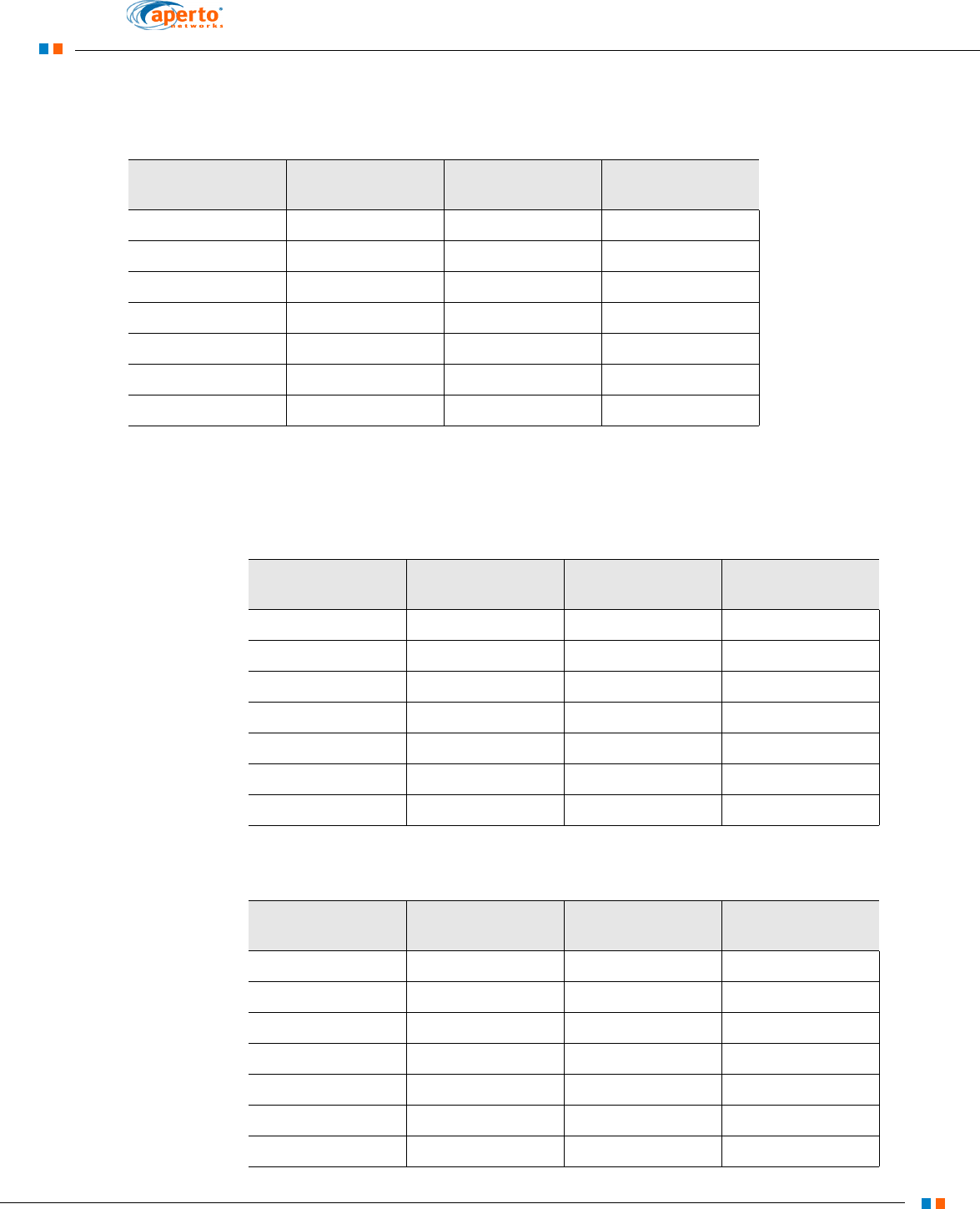
A–3
PacketMax 100 User Manual, 10007306, Rev J
Chapter A. Specifications
1.1.6 Receive Threshold Specifications
Sensitivity PM-100-33
3.5 GHz
PM-100-33
5.5 GHz
PM-100-33
7.0 GHz
BPSK-1/2 -95.1 -93.0 -92.0
QPSK-1/2 -92.1 -90.0 -89.0
QPSK-3/4 -89.6 -87.5 -86.5
16QAM-1/2 -86.6 -84.5 -83.5
16QAM-3/4 -83.1 -81.0 -80.0
64QAM-2/3 79.1 -77.0 -76.0
64QAM-3/4 -77.1 -76.0 -74.0
Sensitivity (dBm
@ BER 10-6)
PM-100-35
3.5 GHz
PM-100-35
5.5 GHz
PM-100-35
7.0 GHz
BPSK-1/2 -95.1 -93.0 -92.0
QPSK-1/2 -92.1 -90.0 -89.0
QPSK-3/4 -89.6 -87.5 -86.5
16QAM-1/2 -86.6 -84.5 -83.5
16QAM-3/4 -83.1 -81.0 -80.0
64QAM-2/3 79.1 -77.0 -76.0
64QAM-3/4 -77.1 -76.0 -74.0
Sensitivity (dBm
@ BER 10-6)
PM-100-33
3.5 GHz
PM-100-33
5.5 GHz
PM-10033
7.0 GHz
BPSK-1/2 3.5 MHz 5.5 MHz 7.0 MHz
QPSK-1/2 -88 -86.0 -85.0
QPSK-3/4 -85 -83.0 -82.0
16QAM-1/2 -82 -80.0 -79.0
16QAM-3/4 -79 -77.0 -76.0
64QAM-2/3 -76 -74.0 -73.0
64QAM-3/4 -73 -71.0 -70.0

A–4
PacketMax 100 User Manual, 10007306, Rev J
Chapter A. Specifications
1.1.7 Mechanical and environmental specifications
PacketMax 100/300 IDU: 0 degC to 40 degC – 10% to 90% relative humidity
PacketMax 100/300 ODU: -35 degC to 60degC – 5% to 95% relative humidity
Environmental: IP67 compliance (If using Aperto cables).
1.1.8 Mounting and Brackets
The Outdoor Units can handle pole diameters between 3.7 cm to 5.1 cm.
1.1.9 Regulatory Standards
Safety Standards : IEC 60951-1 (UL 60950-1 & EN 60950)
EMI Standards : EN5022 and FCC Part 15 Class B
-70 -68.0 -67.0
Sensitivity (dBm
@ BER 10-6)
PM-100-33
3.5 GHz
PM-100-33
5.5 GHz
PM-10033
7.0 GHz
Models Dimensions (W x H x
D)
Weight
PacketMax 100 Outdoor Unit (3.5
GHz)
205x205x67 mm32.2 Kg*
Indoor units Dependent on model

B–1
PacketMax 100 User Manual, 10007306, Rev J
Event Reporting
The PacketMax subscriber equipment can be configured to report events by any of
several means:
E-mail event messages.
SNMP traps.
Logging to a Syslog server.
Reportable alarms and events are identified in Table B-1.
NOTE: Events are highlighted in brackets in the following tables.
B

B–2
PacketMax 100 User Manual, 10007306, Rev J
Chapter B. Event Reporting
B.1 ALarms and Events
NOTE: Events are highlighted in brackets in the following tables.
B.2 PacketMax 100/300 and PacketMax 5000 Events
Table B-1 SS related Alarms
Alarm Type Alarm Message
in EMS
Cause Resolution
Memory System RAM Free :
LOW
System RAM Free :
NORMAL [Event]
/RAM0 Space Free:
LOW
/RAM0 Space Free:
NORMAL [Event]
This indicates the
memory status of the
system.
Contact Aperto
Ethernet Port Link
Change
SS Uplink Ethernet
Port Change
Change in Ethernet
settings
Check Network con-
nections
Radio Frequency
Error
Radio Frequency
Configuration Error
Radio Frequency
Properly Configured
[Event]
Incorrect Frequency
Programmed
Reconfigure the radio
& check radio
Cfg File Parse Status SS Cfg File Parse
Failure
SS Cfg File Success-
fully Parsed [Event]
Config file is not gen-
erated correctly.
Re-check your config-
uration.
Table B-2 SS Events
CPE Mac Addr:<Mac Addr> Wait for DSA/DSC Acknowledge Timer Expired
CPE Mac Addr:<Mac Addr> Initial Ranging Success
CPE Mac Addr:<Mac Addr> Ranging Aborted
CPE Mac Addr:<Mac Addr> Re Range Request
CPE Mac Addr:<Mac Addr> SS search for preamble Timer expired

B–3
PacketMax 100 User Manual, 10007306, Rev J
Chapter B. Event Reporting
CPE Mac Addr:<Mac Addr> Wait for DCD Timer expired
CPE Mac Addr:<Mac Addr> Wait for Broadcast Ranging Timer expired
CPE Mac Addr:<Mac Addr> Wait for Ranging Response Reception Timer
expired
CPE Mac Addr:<Mac Addr> Wait for Unicast Ranging Opportunity Timer
expired
CPE Mac Addr:<Mac Addr> Wait for UCD descriptor Timer expired
CPE Mac Addr:<Mac Addr> SS Wait for DL-MAP on given channel Timer
expired
CPE Mac Addr:<Mac Addr> DBPC-REQ retry Timer expired
CPE Mac Addr:<Mac Addr> RNG-REQ/DBPC-REQ retry Timer expired
CPE Mac Addr:<Mac Addr> DBPC-RSP reception Timer expired
CPE Mac Addr:<Mac Addr> DSA_REQ MAX Retries exceeded
CPE Mac Addr:<Mac Addr> DSA_RSP Re-Sent
CPE Mac Addr:<Mac Addr> MAX DSA RSP retries exceeded
CPE Mac Addr:<Mac Addr> SBC RSP received
CPE Mac Addr:<Mac Addr> REG RSP received
CPE Mac Addr:<Mac Addr> DSA REQ received
CPE Mac Addr:<Mac Addr> DSA ACK received
CPE Mac Addr:<Mac Addr> DSC REQ received
CPE Mac Addr:<Mac Addr> DSC ACK received
CPE Mac Addr:<Mac Addr> DSD REQ received
CPE Mac Addr:<Mac Addr> DSD RSP received
CPE Mac Addr:<Mac Addr> SBC REQ queued
CPE Mac Addr:<Mac Addr> REG REQ queued
CPE Mac Addr:<Mac Addr> Establishing provisioned connection
CPE Mac Addr:<Mac Addr> Wait for DSA, DSC, DSD Response Timer
Expired
CPE Mac Addr:<Mac Addr> Wait for Trasaction End Timer Expired
CPE Mac Addr:<Mac Addr> Wait for DSA/DSC Acknowledge Timer Expired
CPE Mac Addr:<Mac Addr> Wait for Registration Response Timer Expired
CPE Mac Addr:<Mac Addr> Wait for registration response Timer expited
CPE Mac Addr:<Mac Addr> Wait for SBC-RSP Timer Expired
CPE Mac Addr:<Mac Addr> Wait for SBC-RSP Timer Expired
Table B-2 SS Events

B–4
PacketMax 100 User Manual, 10007306, Rev J
Chapter B. Event Reporting

C–1
PacketMax 100 User Manual, 10007306, Rev J
Cables, Spares and Accessories
This appendix provides complete Subscriber Station products, accessories and cable
details for various PacketMax installation requirements.
PacketMax Subscriber Station ODU, cables, spares and their Part numbers are listed
in Table C-1 to Table C-3.
C.1 PacketMax 100/300 CPEs, Cables and Spares
NOTE: The last two digits in the CPEs part number "-XX" specifies the power cord
option where XX is equal to: :
01 = North AM Pwr Cord Option
02 = EU(FR,DE,PL)Pwr Cord Option
03 = EU(CL,IT)Pwr Cord Option
04 = EU(UK,IE)Pwr Cord Option
05 = AUST Pwr Cord Option
06 = South Africa and India Pwr Cord Option
All PacketWave CPE's are AC powered.
C

C–2
PacketMax 100 User Manual, 10007306, Rev J
Chapter C. Cables, Spares and Accessories
3.1.1 PacketMax 100/300 CPEs
3.1.2 PacketMax 100 Cables
Aperto recommends these cables to ensure IP67 weather protection for PM100 and
PM300 series
Table C-1 PacketMax 100/300 Subscriber Stations ODUs
PacketMax Part Number Product Description
PM 100 PM100-35-A-0X Consumer Subscriber Unit with 3.5GHz Transceiver, integrated
antenna
PM100-35-N-0X Consumer Subscriber Unit with connectorized 3.5GHz Trans-
ceiver
PM 300 PM300-35-A-0X Consumer Subscriber Unit with 3.5GHz Transceiver, integrated
antenna
PM300-35-N-0X Consumer Subscriber Unit with connectorized 3.5GHz Trans-
ceiver
Table C-2 PacketMax 100 Weather Proof Ethernet Cable
Part Number Product Description
IP67 Weather Proof, UV protected
50ft Ethernet Cable
PM-IP67-CABLE-50
IP67 Weather Proof, UV protected
100ft Ethernet Cable
PM-IP67-CABLE-100 AND PM-IP67-CABLE-300
IP67 Weather Proof, UV protected
250ft Ethernet Cable
PM-IP67-CABLE-250
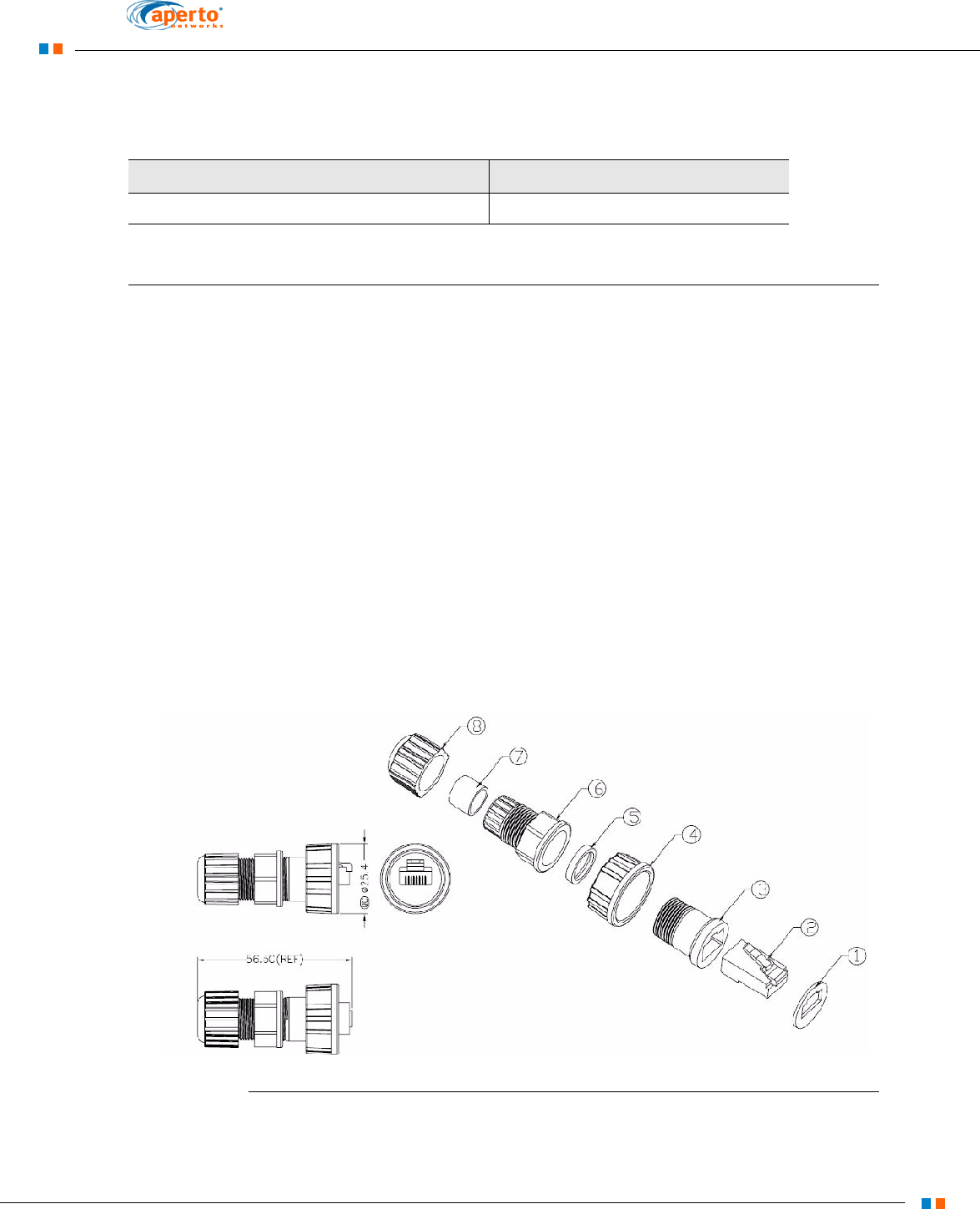
C–3
PacketMax 100 User Manual, 10007306, Rev J
Chapter C. Cables, Spares and Accessories
3.1.3 PacketMAX Subscriber Station Spares and Surge Protector
C.2 Rubber Boot
As mentioned in the Installation chapter, Aperto recommends industrial CAT 5e cable
which meets the ANSI/TIA/EIA 568B.2 Category 5eStandard. In the event that the
above mentioned cable is not available, you must use the included rubber boot, and
use only Industrial CAT5e cable which meets or exceeds ANSI/IIS/EIA 568B.2 Cate-
gory 5e standards that do not exceed 7.8 mm 0D. Product warranties will be void if
these specifications are not met. Figure C-1 displays the parts of the rubber boot in an
assembly, while Table C-4 lists the name and description of the parts,
The procedure for installing the rubber boot is:
1. As shown in Figure C-1, slide the Sealing Nut (8), Seals (7), Clams Ring (6),
Gasket (5), Screw Nut (4) and Body (3) in to the CAT 5e cable.
2. Strip the cable and crimp in to the Plug (ethernet connector, 2) after attaching
the Gasket (1) to the Body (3).
3. Plug the ethernet connector (2) and then turn the Screw Nut (4) to tighten.
Figure C-1 Rubber boot for CAT5 Cable
Table C-3 Cable Specs
Part Number Product Description
Spare Pole Mounting Kit for PM100 and PM300 CPE PM100/300-POLEMOUNT

C–4
PacketMax 100 User Manual, 10007306, Rev J
Chapter C. Cables, Spares and Accessories
Table C-4 Rubber Boot parts
No. QTY Name Color Specification QTY
8 Sealing Nut Black Nylon 1
7 Seals Black EPDM 1
6Clams Ring Black Nylon 1
5 Gasket Black EPDM 1
4Screw Nut Black Nylon +GF 1
3Body Black PC+ABS 1
2Plug 8P8C 1
1Gasket Black EPDM 1

D–1
PacketMax 100 User Manual, 10007306, Rev J
Command Line Interface (CLI)
Each Subscriber Station includes a simple command line interface (CLI) accessible
via telnet. The CLI is intended primarily for troubleshooting and debug use under
direction of Aperto personnel.
NOTE: CLI is not a supported management interface.
D.1 Accessing and Using the CLI
To access and use the Subscriber Unit’s command line interface:
1. Telnet to the Subscriber Unit’s IP address.
2. At the Login: prompt, enter the desired logon level: ISP. (There is also a Debug
logon level, which is reserved for Aperto use.)
NOTE: All CLI entries, including user name and password, are case-sensi-
tive.
3. At the Password: prompt, enter the correct password for the specified logon
level.
NOTE: The default password is isp. Passwords can be changed via the
WaveCenter Configuration Manager, SNMP, and the CLI.
4. When the CLI# prompt appears, you are in the CLI.
a. For a list of commands, type ? (the ? will not appear on the screen; press-
ing [Enter] is not necessary). The CLI will respond with a list of the avail-
able commands groups.
b. To see the specific commands in a group, type the group name followed
by ? (again, the ? will not appear, and pressing [Enter] is not necessary).
D

D–2
PacketMax 100 User Manual, 10007306, Rev J
Chapter D. Command Line Interface (CLI)
c. To display information about the use of a specific commands, including
command parameters, enter the command followed by ?.
5. When you are finished with the CLI, end the Telnet session by entering the
logout command or simply closing the Telnet application.
4.1.1 Commands
Some Subscriber Unit CLI commands are defined in Table D-1. All commands are
case-sensitive. Please refer to the Command Line Interface Reference Manual Rev
B, for further CLI details.
4.1.2 Error Messages
Error messages which may be returned by the Subscriber Unit CLI include the follow-
ing:
Error: Bad Command — command has been entered incorrectly.
Error: Invalid Parameter — command has been entered incorrectly.
Verification failed: Invalid use/current password — when setting a password, user-
name or password entries do not match.
Table D-1 Subscriber Unit CLI Commands
Command Function
killTelnet Causes the CLI to terminate all current Telnet sessions con-
nected at port 5000.
reboot Reboots the Subscriber Unit.
config dhcp params Configures dhcp params
config vlan params Sets vlan parameters.
config password These commands set passwords for any login CLI prompts for
old and new password.
show dhcp params Shows the DHCP parameters, including IP address, subnet
mask, and gateway, TFTP servers, and config file name.
show device running config file Generates the Subscriber Unit’s configuration file in text format.
File is stored in /ram0 directory.
show frequency params Displays frequency of SS.
show vlan params Does not apply to Subscriber Unit.
show config vlan Shows the management VLAN parameters.
show system Displays system parameters, for e.g.:, location, memory-info and
ss-model, etc.
show wimax status Displays some status parameters, for e.g:, currentTXpower, Ds-
modulation and tffso-free-bytes, etc.

E–1
PacketMax 100/300 User Manual, 10007306, Rev J
Chapter E. Virtual Local Area Network
Virtual Local Area Network
This chapter provides the Virtual Local Area Network connection on Subscriber Sta-
tion, it use and examples of user scenarios.
This chapter covers the following topics:
Bridge and VLAN Mode
Out of band Management with Management VLAN
Inband Management with Management VLAN
VLAN Classifiers
VLAN Application Example
Looping Prevention
Subscriber Station scenarios
E

E–2
PacketMax 100/300 User Manual, 10007306, Rev J
Chapter E. Virtual Local Area Network
E.1 Bridge and VLAN Mode
PacketMax products may be deployed in following modes of operation:
Bridge Mode: In the bridge mode, data and management traffic is forwarded.
VLAN Mode: Virtual Local Area Networks (VLANs) is a method that allows
network administrators to create logical broadcast domains, which implies
division of local area network by software rather than using cables. The
broadcast domains can span across one switch or multiple switches. Thus
VLANs:
-Reduces the size of broadcast domains
-Reduces network traffic
-Increases Network security
-Reduces the need to create subnetworks
-Enables network to be logically separated and not physically.
For the Data Traffic in the VLAN Mode, the VLAN IDs are configured when
provisioning SS using EMS.
E.2 Out of band Management with Management
VLAN
Outbound Management traffic adds security, when the management VLAN is
enabled. The outbound management is tagged with this VLAN ID. Both BS and SSs
should use same VLAN ID as Management VLAN ID. For example, if VLAN ID num-
ber is 1 on BS, it has to be the same (VLAN ID 1) on SS as well. The management
VLAN ID needs to be set:
On the PM5000 BS, manually.
NOTE: Changing Management Port in VLAN requires MSC reboot.
On the SS, using the Installation Manager.
Please refer to Chapter 6 “Commissioning the Base Station”, for setting up Manage-
ment VLAN ID on the BS and refer to the PacketMax 100/300 User Manual for setting
up the Management VLAN ID on the SS.
Typically management port is used for sending/receiving management traffic (Ping/
TFTP/DHCP packets from/to BS or SS). Figure E-1 displays DHCP/TFTP over man-
agement port (a management interface set-up).
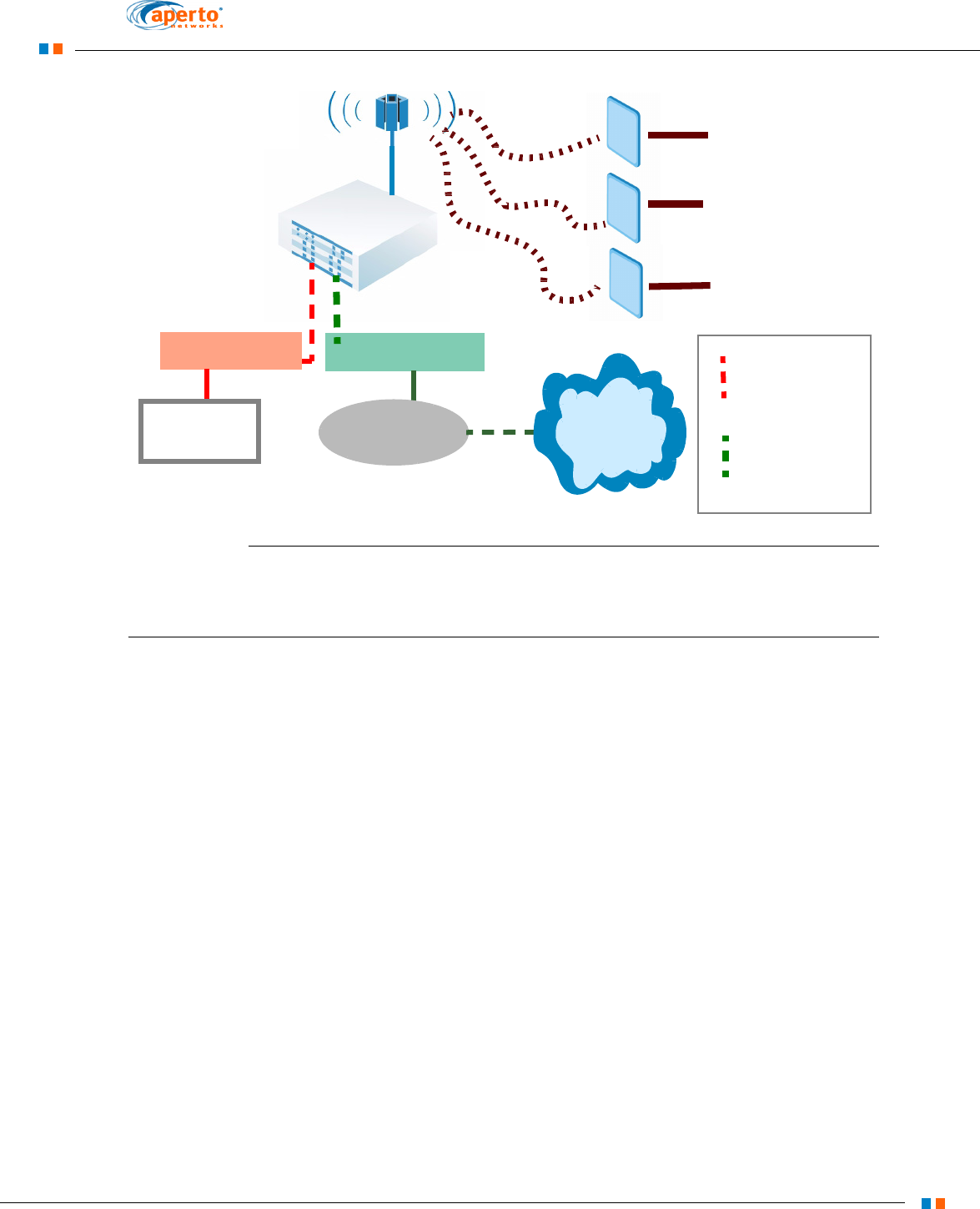
E–3
PacketMax 100/300 User Manual, 10007306, Rev J
Chapter E. Virtual Local Area Network
Figure E-1 Out of band Management
E.3 Inband Management with Management VLAN
The date/traffic are segmented by traffic VLANs and is implemented by the backhaul
ports (Inband management). This VLAN carries inbound traffic.
The Backhaul Interface can be either Fast Ethernet or Gigabit interfaces. Backhaul
port could be used for sending/receiving data traffic. Figure E-2 displays DHCP/TFTP
over backhaul port (a backhaul interface set-up).
EMS Server Router
VLAN 2, 3
VLAN 5
VLAN 4
Internet
VLAN Switch VLAN Switch Management Port
Connection
Backhaul Port
Connection
DHCP/TFTP over
Management Port
BS
SS
SS
SS
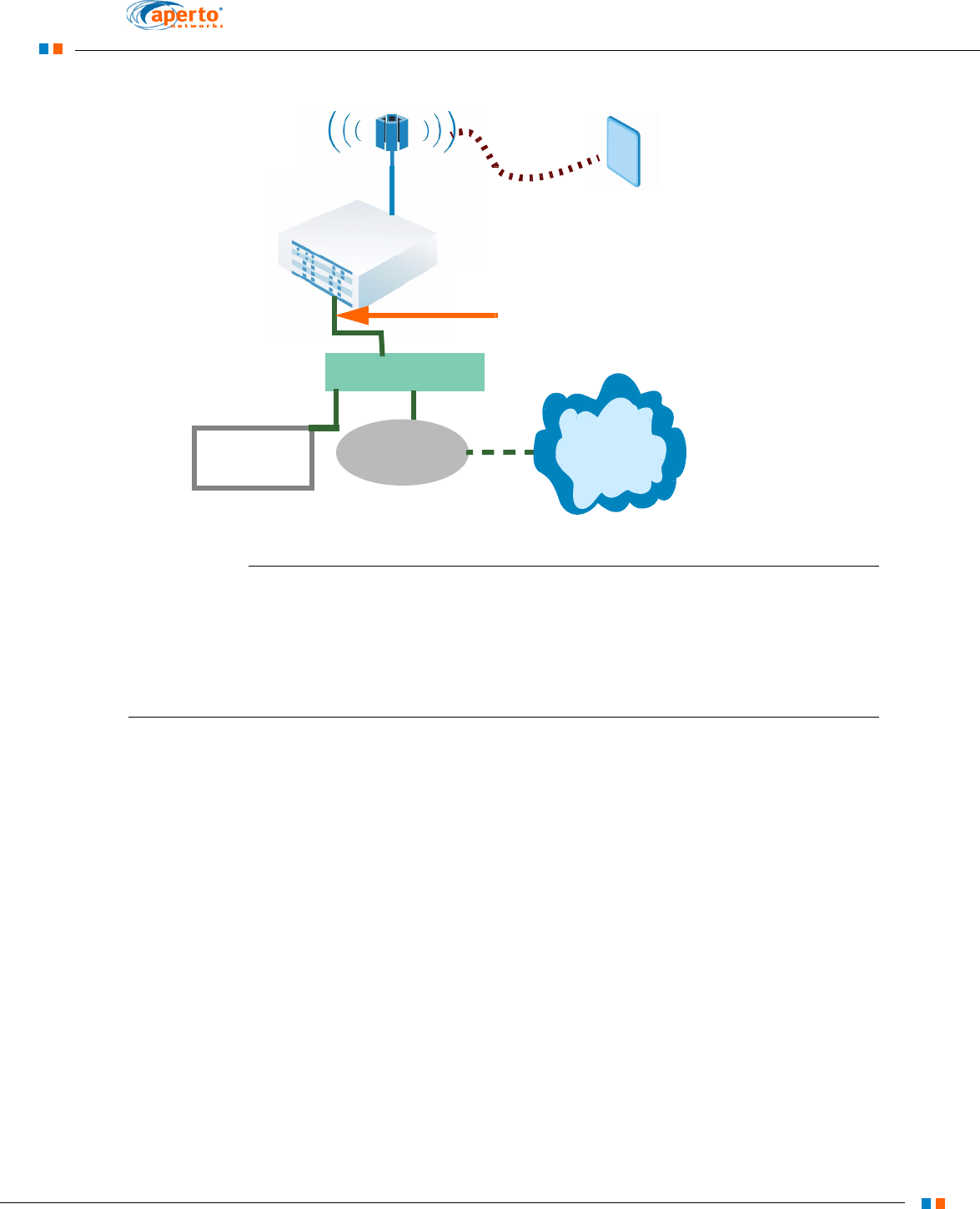
E–4
PacketMax 100/300 User Manual, 10007306, Rev J
Chapter E. Virtual Local Area Network
Figure E-2 Inband Management
It is recommended to connect EMS server and Base station unit in the same VLAN,
for the ease of management and quick troubleshooting incase of any failures.
E.4 VLAN Classifiers
The VLAN switch identifies traffic corresponding to each LAN interface by attaching a
VLAN tag to the Ethernet frame as the traffic is switched to its WAN interface. The
Ethernet switch provides isolation of one customer LAN traffic from another custom-
ers. As each customer’s traffic can be identified with a VLAN ID, it can be mapped
onto an individual Service Flow enabling individualized QoS on a per customer basis.
A VLAN Classifier is a set of rules that determine how the PM 100/PM 300 assigns a
VLAN ID and priority to a packet based on a wide range of packet parameters such
as:
Source or destination IP address(es).
Source or destination MAC address(es).
IP TOS.
EMS Server Router Internet
VLAN Switch
DHCP/TFTP over
Backhaul Port
BS
SS
Trunk carrying Data and
Management traffic Connection
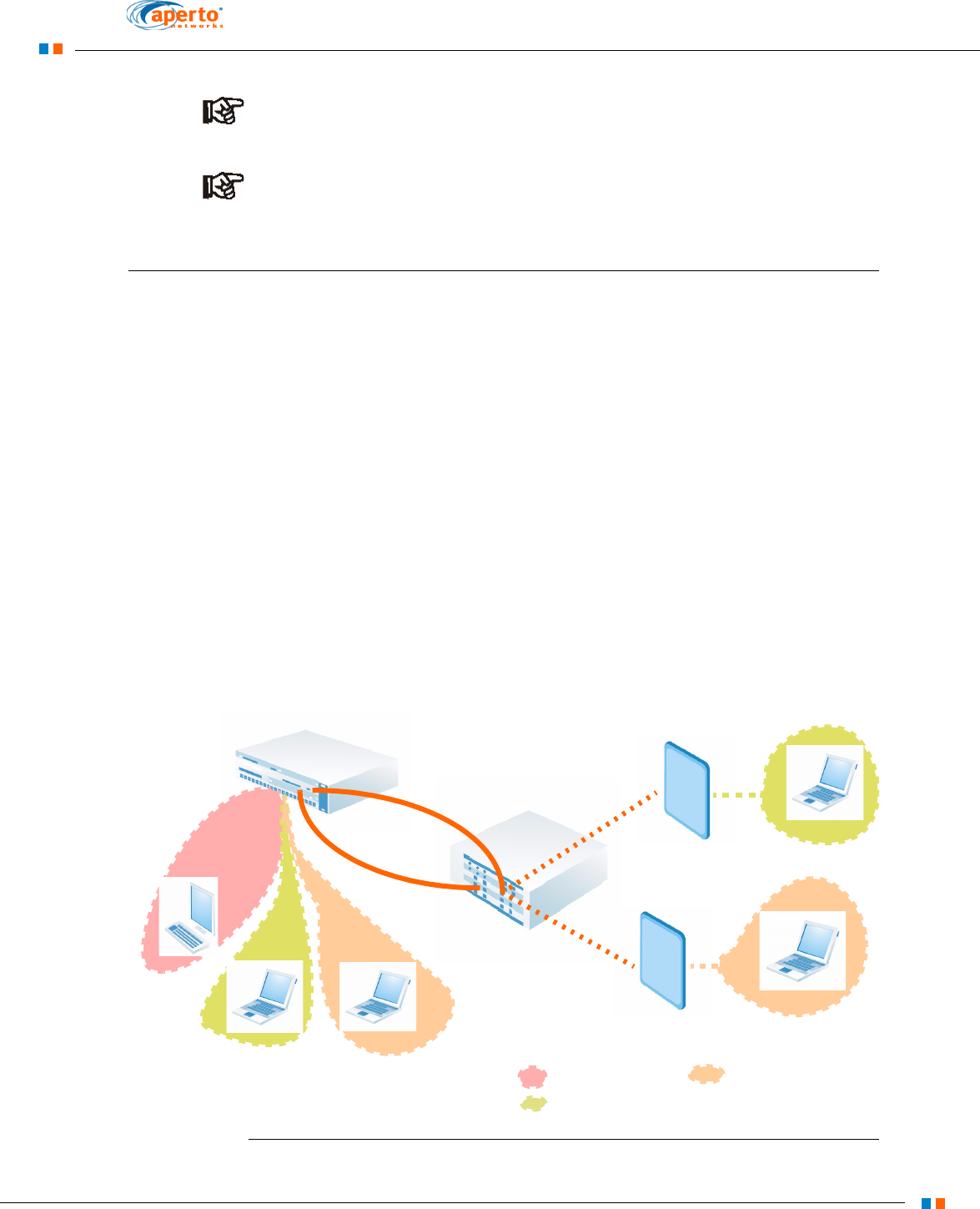
E–5
PacketMax 100/300 User Manual, 10007306, Rev J
Chapter E. Virtual Local Area Network
TCP/UDP Port numbers.
NOTE: VLAN classifiers are applied only when the unit is configured with
them enabled. This is configured in EMS, and is described in the WaveCenter
EMS User manual.
NOTE: IP addresses used for VLAN classifiers do not warn the user when
the resulting address is the broadcast or network address.
E.5 VLAN Application Example
An example (Figure E-3 )using the Point-to-Multipoint PacketMax 5000 Product with
two SSs (Subscriber Station) and a Cisco 2950 Series VLAN switch is described in
this section.
The Base Station Backhaul Fast Ethernet Port is Trunked, via the MSC (Main
System Controller), to the Cisco 2950 Series VLAN Switch.
Two ports on Cisco VLAN Switch are configured in Access mode to tag all
incoming packets. The first port is configured with VLAN ID 101 and the sec-
ond VLAN ID 102; these ports are used to connect non VLAN enable devices.
Two PacketMax SSs are configured in VLAN mode to tag all incoming pack-
ets. One SS is configured to tag all incoming packets with ID 101 and the
other with ID 102.
The PacketMax products (MSC and SS) are configured to be managed using
VLAN ID 100. Hence, another Port on the VLAN switch is configured to tag
all packets coming from the EMS Server with VLAN ID 100 to the Base Sta-
tion Management interface on the MSC.
Figure E-3 VLAN Application
Trunk - Backhaul
PC 172.16.0.1
PC 172.16.0.1
PC 172.16.0.2
VLAN 100
VLAN 101
VLAN 102
Trunk -
Management
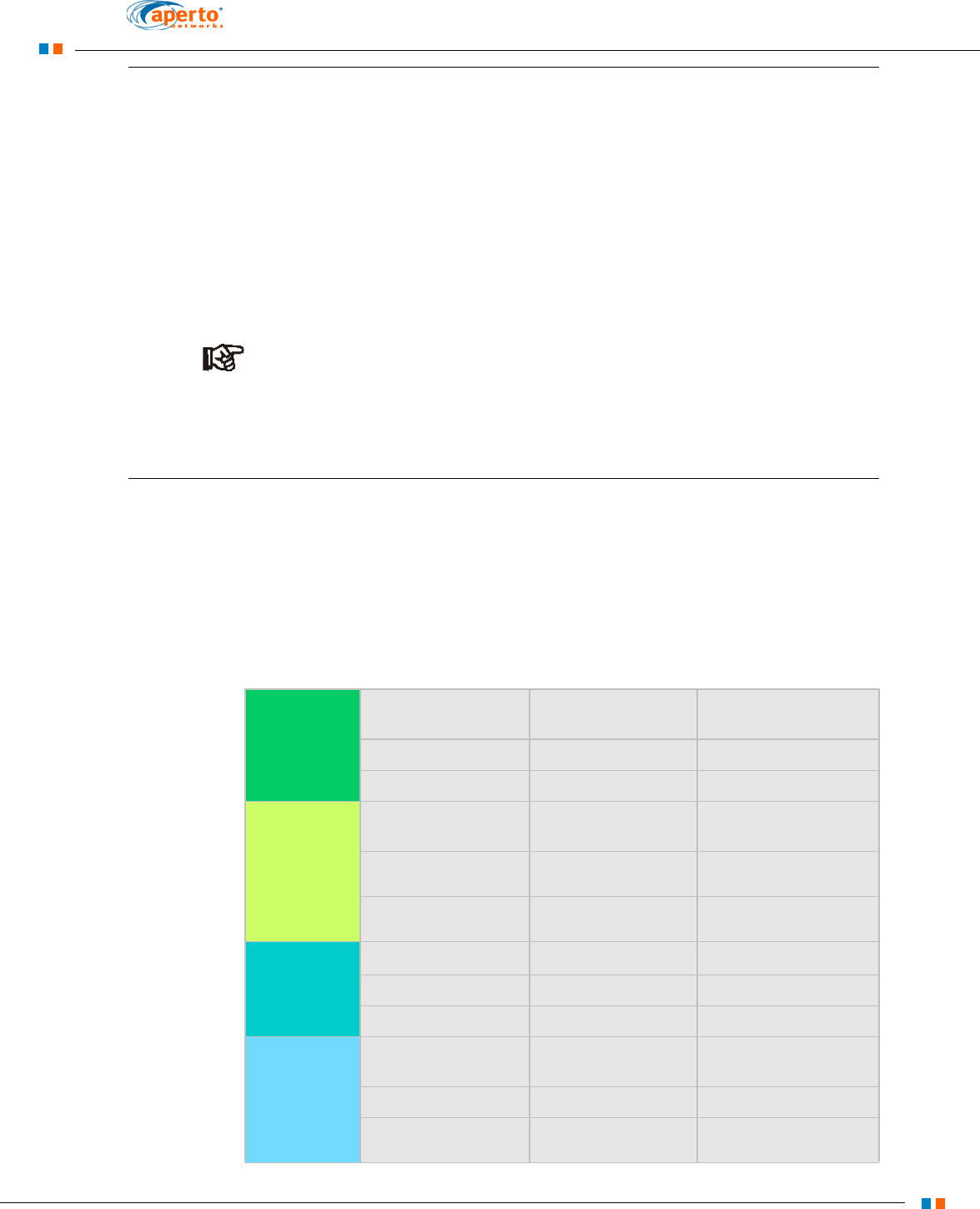
E–6
PacketMax 100/300 User Manual, 10007306, Rev J
Chapter E. Virtual Local Area Network
E.6 Looping Prevention
The communication between SS and PM 5000 and the communication between SS
and EMS server occurs over the management VLAN. The management traffic des-
tined to EMS server from SS is sent out only on management port of PM5000 and it
will not be sent out of backhaul port.
Also, if backhaul port receives any management traffic, it will drop it. Hence, if you
try to ping PM5000 (which is in VLAN Mode) using management VLAN ID through
backhaul, it will not work. Ping will work if it is tagged with appropriate management
VLAN ID and it is sent through management port.
NOTE: Base Station Unit and Subscriber Stations need to be configured in the
VLAN Mode to avoid any configuration issues. It is not recommended to run the
base station in the Bridge Mode and Subscriber station in the VLAN Mode. However,
this combination might work but we do not guarantee and Aperto does not support
in this mode.
E.7 Subscriber Station scenarios
There are a few scenarios in which Base Station and Subscriber Station behave and
this depends on the mode they are in. These scenarios are captured in the Table E-1:
Table E-1 Subscriber Station behavior in different scenarios
Scenario 1
Device Mode Management VLAN
ID
Base Station Bridge Should not be set
Subscriber Station Bridge should not be set
Scenario 2
Device Mode Management VLAN
ID
Base Station VLAN Data is tagged, whether
or not set
Subscriber Station VLAN Data is tagged, whether
or not set
Scenario 3
Device Mode Data Traffic
Base Station N/A N/A
Subscriber Station VLAN See Table E-2
Scenario 4
Device Mode Network Manage-
ment
Base Station N/A N/A
Subscriber Station VLAN No Set-up.
See Table E-3

E–7
PacketMax 100/300 User Manual, 10007306, Rev J
Chapter E. Virtual Local Area Network
Table E-2 VLAN behavior - Data traffic only
Scenario 5
Device Mode Network Manage-
ment
Base Station N/A N/A
Subscriber Station VLAN Set-up.
See Table E-4.
Table E-1 Subscriber Station behavior in different scenarios
VLAN Mode Network Management (Set)
Allow-all Tag Only
Set Allowed Allowed
Not Set
[Default VLAN]
Allow *N/A
* This is not applicable as, for the
Tag Only option, Default VLAN
cannot be set in EMS.

E–8
PacketMax 100/300 User Manual, 10007306, Rev J
Chapter E. Virtual Local Area Network
Table E-3 Management traffic with no Network Management (NM) Set-up
Table E-4 Management traffic with NM
5.7.1 Behavior of SS VLAN
The following tables have depicted a matrix of the behavior of SS VLAN particularly
from LAN, under different cases:
Case 1 : When Network Management VLAN ID is equal to “0” and all Packets are
allowed.
Case 2: When Network Management VLAN ID is not equal to “0” and all Packets are
allowed.
Case 3: When Network Management is “0” and only Tagged Packets are allowed.
Case 4: When Network Management VLAN ID is not equal to “0” and only Tagged
Packets are allowed.
VLAN Mode Allow-all Tag Only
Set
Drop Drop
Not Set
[Default VLAN]
VLAN ID Allow-all Tag Only
Set
Drop Drop
Not Set
[Default VLAN]
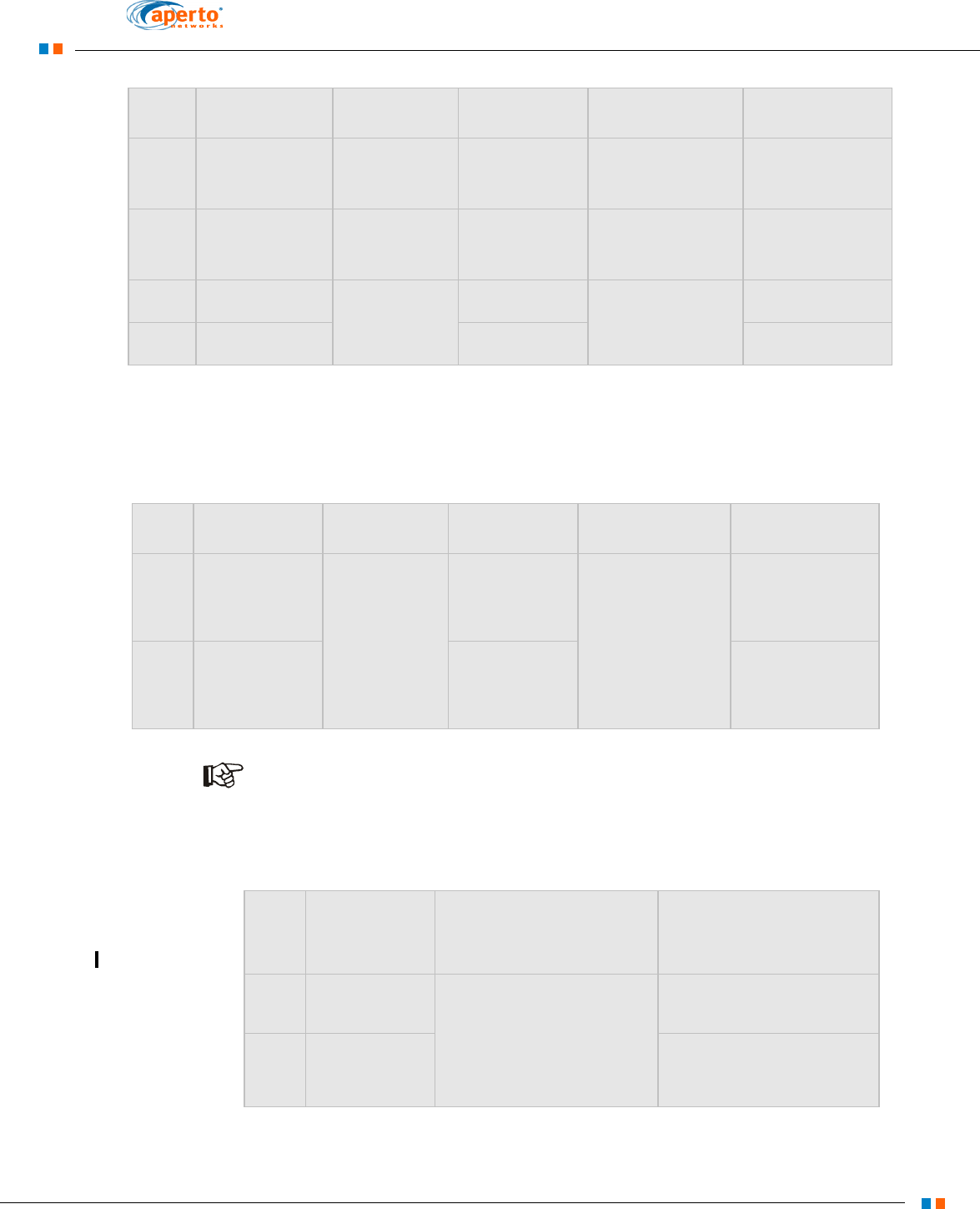
E–9
PacketMax 100/300 User Manual, 10007306, Rev J
Chapter E. Virtual Local Area Network
Table E-5 SS VLAN on LAN side for Packet Traffic
Table E-6 SS VLAN on LAN side for Ping
NOTE: “*” implies that Ping Request is dropped.
Table E-7 SS BRIDGE on LAN side for Ping
S.No FROM LAN Case 1 Case 2 Case 3 Case 4
1Tagged Packet
(Configured
VlanId)
Allowed Allowed Allowed Allowed
2Tagged Packet
(Not Configured
VlanId)
Dropped Dropped Dropped Dropped
3Tagged Packet
(with NM VlanId)
Allowed
(Untagged)
Dropped Dropped
(Untagged)
Dropped
4Untagged Packet Allowed Dropped
S.No FROM LAN Case 1 Case 2 Case 3 Case 4
1Ping Using NM
VlanId
Dropped
(Ping Reply is
dropped at
vlasnTkOutput
of iProEth)
Dropped *
(at vlanTkInput of
iProEth)
Dropped *
(at vlanTkInput of
iProEth)
Dropped *
(at vlanTkInput of
iProEth)
2Ping Using
Untagged Packet
Dropped *
(at vlanNmInput-
function)
Dropped *
(at vlanTkInput of
iProEth)
S.No FROM LAN Network Management = 0
Network Management is
not “0”
1Ping Using NM
VlanId
Working Working
2Ping Using
Untagged Packet
Dropped *
(at vlanNmInputfunction)

E–10
PacketMax 100/300 User Manual, 10007306, Rev J
Chapter E. Virtual Local Area Network

F–1
PacketMax 100 User Manual, 10007306, Rev J
Chapter F. Troubleshooting
Troubleshooting
F.1 Troubleshooting Issues and Tips
Please refer to the following table for symptoms and possible solutions for both the
Subscriber Station and Base Station.
SYMPTOM/PROBLEM WHAT IT MAY MEAN WHAT TO DO
Subscriber Station
Subscriber Station is having
issues synching up with Base
Station
Incorrect Frequency Check AIM has the correct values for
all these factors and if they are correct,
then check the settings in WSS config
file, under EMS.
Incorrect Channel Width
Incorrect BS ID
BS wireless port is not operational
SS Indoor Unit (PoE) failed to detect
the Outdoor Unit
Check if all the cabling is in place.
The SS is out of range from the BS and
is not able to receive any signal from
the BS
Check the Base Station Radio connec-
tivity.
SS is not receiving IP address
from the EMS server.
The EMS Server may not have the cor-
rect reservation for the SS.
Check the MAC address which might
be wrong.
The EMS Server may be not opera-
tional.
Check the EMS server on the machine
on which it was installed and confirm if
the process is running.
F

F–2
PacketMax 100 User Manual, 10007306, Rev J
Chapter F. Troubleshooting
F.2 Booting SS from network
Symptoms
SS does not come up during installation of AIM. This happens when the installation
process in on the last screen of AIM, which has the CINR and RSSI graph. AIM
reports that SS is not connected and you will see that your Ethernet link of PC is
going up and down continuously. After that you cannot telnet to SS IP Address. There
will be no long beep for ARM1 bootup.
Resolution
This usually happens because AIM tool tries to write the value of frequency and other
parameters, that the user has configured, into NVRAM. While writing to NVRAM if
there is some weak signal received, than ARM1 causes MPI error and that results in
ARM0 also being rebooted. If ARM0 is in middle of writing parameters to NVRAM and
ARM1 made ARM0 reboot itself, than NVRAM gets corrupted. Also the bootline on
SS is corrupted and it falls back to default bootline, which is to boot from network. To
restore bootline back to original values, follow the procedure as below:
1. Connect the Ethernet port of your laptop to the SS using a crossover cable.
2. Change the IP address of your Ethernet card to 192.168.2.55.
To achieve this, follow the instructions below :
a. Double click on the Network Connections icon in the control panel.
b. Double click on Network card to which SS is connected and a screen as
displayed in Figure F-1 appears.
SS cannot register all its
service flow.
If the number of SSs registering
exceeds the number of supported SSs
configure in the BS.
Move the SS to another sector.
If the SS’s configuration file specifies a
larger number of Classifiers.
Reduce number of Classifiers.
The SS’s configuration file specifies
Service Flows for which the BS does
not have any reserved bandwidth.
Install more capacity or move the SS to
another sector.
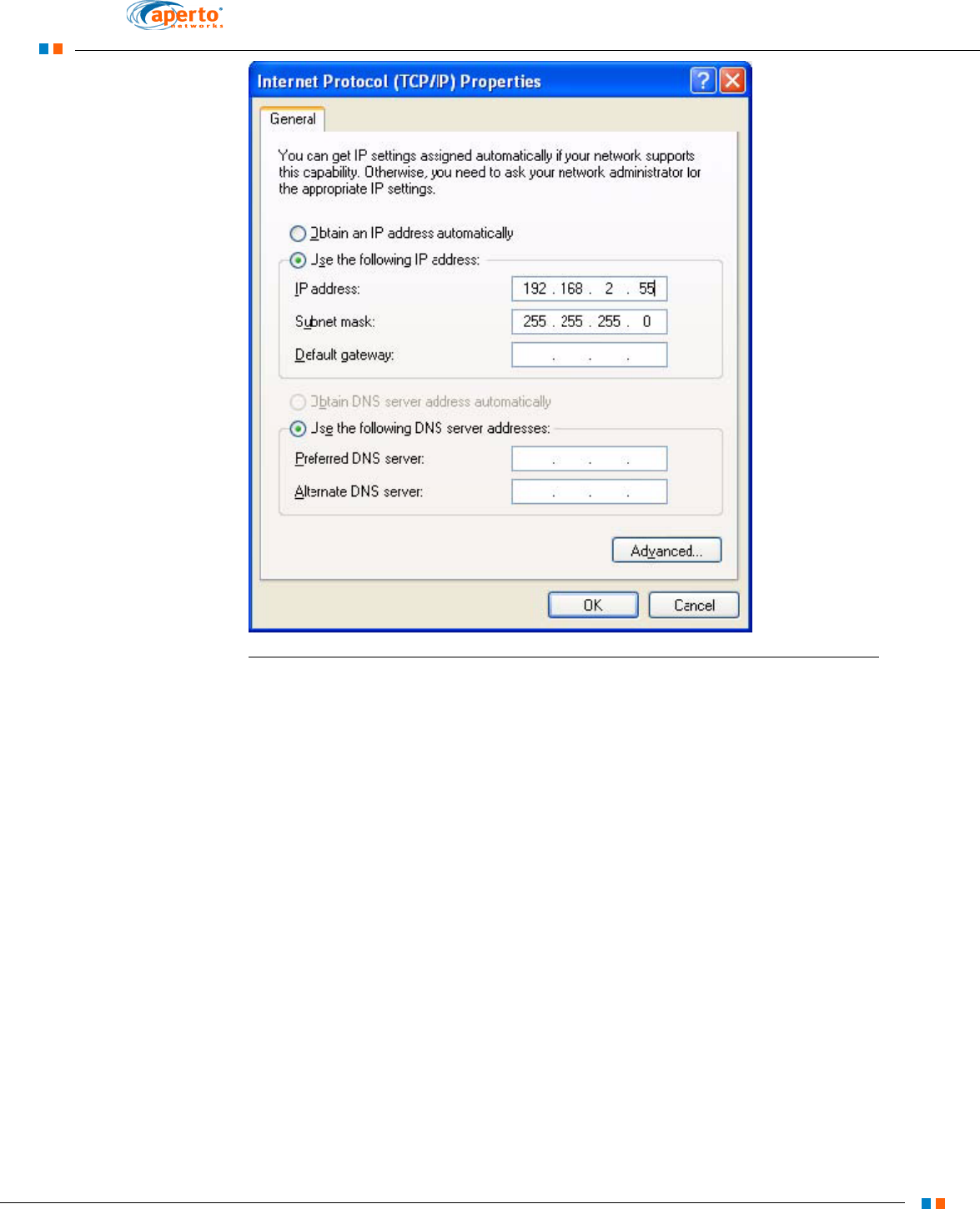
F–4
PacketMax 100 User Manual, 10007306, Rev J
Chapter F. Troubleshooting
Figure F-2 IP settings page
d. Copy the following files from build 72 to a temporary directory:
-c:\temppm-100_upgrade\arm0_ss1_0_0.D
-c:\temppm-100_upgrade\arm1_vxWorks.D
-c:\temppm-100_upgrade\ arm1_bootrom.bin
e. Start ftp server and create user called vxuser and password vxuser with
home directory pointing to c:\temp. If you are using tornado’s ftpd server
start ftpserver by running wftpd32.exe.
f. Select the Security menu item and than Users/rights and the sub menu
under that. Create new user called vxuser with password of vxuser and
home directory c:\temp (Figure F-3 ).
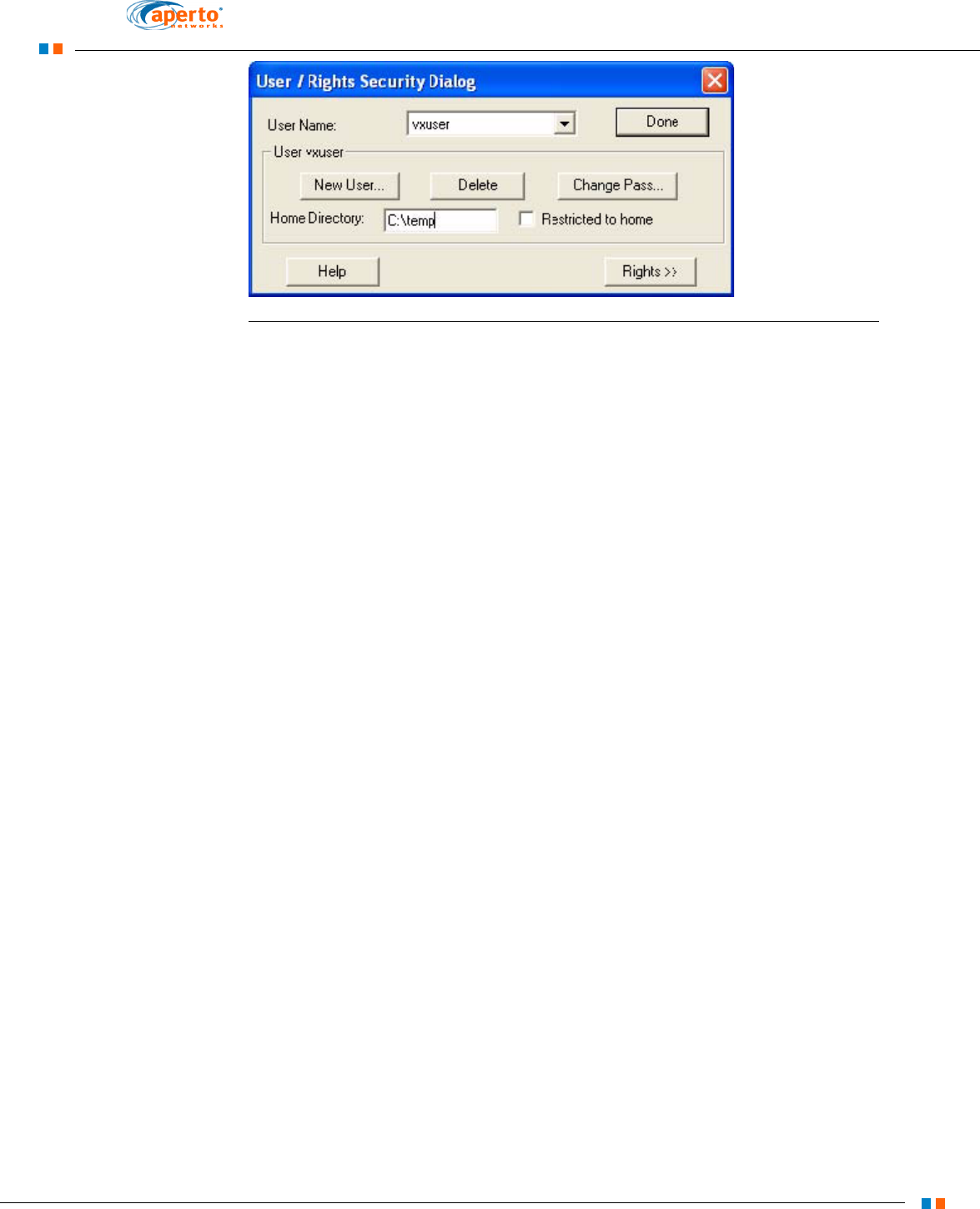
F–5
PacketMax 100 User Manual, 10007306, Rev J
Chapter F. Troubleshooting
Figure F-3 Security dialog box
g. Power off the SS and start it again.
h. Now the SS boots up from your PC and you will hear the beep for ARM1
bootup.
i. Telnet to SS and change the boot parameters as below:
telnet <ss_ip_address> 5000
login:- isp
password:- isp
SS Main> bootChange
'.' = clear field; '-' = go to previous field; ^D = quit
boot device : tffs=0,0
processor number : 0
host name : host
file name : /tffs0/arm0_ss1_0_0.D
inet on ethernet (e) : 192.168.2.100:ffffff00
inet on backplane (b): 127.0.1.1:ffffff00
host inet (h) : 192.168.2.55
gateway inet (g) : 192.168.10.1
user (u) : vxuser
ftp password (pw) (blank = use rsh): vxuser
flags (f) : 0x2008
target name (tn) :
startup script (s) :

F–6
PacketMax 100 User Manual, 10007306, Rev J
Chapter F. Troubleshooting
other (o) :iProEth0
value = 0 = 0x0
SS Main>
j. Shutdown the ftp server on your laptop by closing the wsftp32.exe
k. Reboot SS by disconnecting the power supply to power brick and con-
necting it back
l. Check if SS comes up on its own by doing a telnet to 192.168.2.100 on
port 5000 by typing the following commands information on the dos
prompt of your PC after you hear the long beep sound of ARM1 reboot.
-telnet 192.168.2.100 5000
-login:- isp
-password:- isp
m. If your telnet session lets you login you have successfully set the bootpa-
rameters.

G–1
PacketMax 100 User Manual, 10007306, Rev J
LIMITED EQUIPMENT WARRANTY
(“Agreement”)
G.1 WARRANTY COVERAGE
Aperto Networks, Inc. (“Aperto”) warrants that this equipment (“Product”) shall be free from
physical defects in material and workmanship under normal use, is manufactured solely from
new parts, and substantially conforms to published specifications for a period of one (1) year
from the date of purchase (the “Warranty Period”). This Agreement only applies to end
customers who purchase the Product directly from Aperto or from an Aperto authorized
reseller (“End Customers”). End Customers that obtain this Product as part of a service from
a third party service provider should contact the service provider for their respective warranty
and repair policies.
If the Product proves defective during the Warranty Period, contact Aperto or the authorized
Aperto reseller, as applicable, who is providing support for the Product. Be prepared to
provide the Product model number, description and serial number along with a description of
the problem. Please have proof of purchase and serial number available. In the event the
problem can be corrected with a software update, you may be instructed to download the
software from the Aperto ftp site.
No Product will be accepted for repair or replacement by Aperto or its authorized resellers
without a Return Material Authorization (“RMA”) number. End Customers must complete
and submit an RMA request in order to obtain an RMA number. RMA request forms can be
obtained by request to Aperto and also on Aperto’s website at http://www.apertonet.com/
support. Once the request is completed and submitted by the End Customer and validated by
Aperto, Aperto will issue End Customer an RMA number by email. When returning a
Product, mark the RMA number clearly on the outside of the package and include a copy of the
F

G–2
PacketMax 100 User Manual, 10007306, Rev J
Chapter G. LIMITED EQUIPMENT WARRANTY (“Agreement”)
proof of purchase. End Customers are responsible for shipping and handling charges incurred
in returning a Product to Aperto.
LIMITATIONS OF WARRANTY
The express warranties set forth in this Agreement will not apply to defects caused; (i) through
no fault of Aperto during shipment to or from customer, (ii) by the use of software other than
that provided with or installed in the Product, (iii) by the use or operation of the Product in an
application or environment other than that intended or recommended by Aperto, (iv) by
modifications, alterations, or repairs made to the Product by any party other than Aperto or
Aperto’s authorized repair partners, (v) by the Product being subjected to unusual physical,
electrical, or environmental stress, or (vi) by failure of customer to comply with any of the
return procedures specified in this Agreement.
WARRANTY DISCLAIMER
EXCEPT AS SET FORTH EXPRESSLY IN THIS DOCUMENT, APERTO MAKES NO
WARRANTY OR REPRESENTATION, EXPRESSED, IMPLIED, OR STATUTORY,
WITH RESPECT TO ITS PRODUCTS OR THE CONTENTS OR USE OF THIS
DOCUMENTATION AND ANY ACCOMPANYING SOFTWARE. WITHOUT
LIMITATION, APERTO DISCLAIMS ALL IMPLIED WARRANTIES, INCLUDING
IMPLIED WARRANTIES OF QUALITY, PERFORMANCE, MERCHANTABILITY, AND
FITNESS FOR A PARTICULAR PURPOSE. APERTO RESERVES THE RIGHT TO
REVISE OR UPDATE ITS’ PRODUCTS, SOFTWARE, AND DOCUMENTATION
WITHOUT OBLIGATION TO NOTIFY ANY INDIVIDUAL OR ENTITY.
7.1.1 REMEDIES
Subject to End Customer’s compliance with Aperto’s return policies and subject also
to the limitations of Aperto’s warranty as described above, Aperto will repair or replace
any defective Product during the Warranty Period. Once repaired or replaced, Aperto
will pay for return shipment back to End Customer. In case of replacement, the
replacement Product need not be new or of an identical make, model or part; Aperto
may at its discretion replace the defective Product or any part thereof with any recon-
ditioned product that Aperto reasonably determines is substantially equivalent or
superior in all material respects to the defective Product. Aperto warrants any
replaced or repaired Product or part for ninety (90) days from shipment or the remain-
der of the initial Warranty Period whichever period is longer. Aperto does not provide
refunds for its Products. End Customer’s sole and exclusive remedy and Aperto' sole
and exclusive liability during the Warranty Period shall be the repair or replacement
of the defective Product at no charge. THESE EXCLUSIVE REMEDIES SHALL NOT
BE EXPANDED TO INCLUDE ANY OTHER REMEDIES, EVEN IF THE REMEDIES
PROVIDED HEREIN FAIL OF THEIR ESSENTIAL PURPOSE.

G–3
PacketMax 100 User Manual, 10007306, Rev J
Chapter G. LIMITED EQUIPMENT WARRANTY (“Agreement”)
G.2 LIMITED LIABILITY
TO THE FULL EXTENT ALLOWED BY LAW, APERTO EXCLUDES, AND END CUS-
TOMER ACCEPTS THE EXCLUSION OF, ANY LIABILITY, WHETHER BASED IN
CONTRACT, TORT (INCLUDING NEGLIGENCE OR ANY OTHER CAUSE OF
ACTION), FOR ANY INCIDENTAL, CONSEQUENTIAL, INDIRECT, SPECIAL, OR
PUNITIVE DAMAGES OF ANY KIND OR FOR LOSS OF REVENUE OR PROFITS,
LOSS OF BUSINESS, LOSS OF INFORMATION OR DATA, OR OTHER FINANCIAL
LOSS ARISING OUT OF OR IN CONNECTION WITH THE SALE, INSTALLATION,
MAINTENANCE, USE, PERFORMANCE, FAILURE, OR INTERRUPTION OF ITS’
PRODUCTS, ACCOMPANYING SOFTWARE, AND DOCUMENTATION, EVEN IF
APERTO HAS BEEN ADVISED OF THE POSSIBILITY OF SUCH DAMAGES, AND
LIMITS ITS LIABILITY TO REPAIR OR REPLACEMENT AT APERTO'S OPTION.
APERTO FURTHER DISCLAIMS ALL LIABILITY FOR PERSONAL INJURY OR
DEATH, OR PROPERTY DAMAGE ARISING FROM CUSTOMER'S NEGLIGENT
USE OF THE PRODUCTS OR THEIR COMPONENTS, INCLUDING BUT NOT LIM-
ITED TO CUSTOMER'S FAILURE TO PROPERLY INSTALL THE PRODUCTS OR
THEIR COMPONENTS.
Please direct all inquiries regarding this warranty to Aperto at: rma@apertonet.com

G–4
PacketMax 100 User Manual, 10007306, Rev J
Chapter G. LIMITED EQUIPMENT WARRANTY (“Agreement”)
